The Mauritanian team secured a spot in the Africa Cup of Nations in Ivory Coast, marking its third appearance in its history and remarkably its third consecutive one, after making its debut in the 2019 edition in Egypt and then qualifying for the 2021 edition, which was held in 2022 because of corona, in Cameroon. This reflects the advancement of Mauritanian football despite their elimination from the group stage in both tournaments.
“The stagnation that afflicts Mauritanian football is not a predetermined destiny that we must accept, but it is a malady that requires a remedy.” With these words, the Mauritanian football revival was initiated by its proponent Ahmed Yahya, the incumbent president of the Mauritanian Football Federation.
Football in Mauritania faced many challenges, resulting in severe sanctions on the Mauritanian team for its withdrawal from the qualifiers for the 2010 Africa Cup of Nations, but the situation improved with the appointment of Ahmed Yahya as the president of the Mauritanian Football Federation in 2011. Ahmed Yahya developed a strategy that lifted Mauritanian football out of the gloomy tunnel it was in, and the progress did not only encompass the first Mauritanian team but also spanned many sectors of football in Mauritania.
The Mauritanian Football Federation utilised $11.1 million allocated by the FIFA program to enhance the infrastructure and implement a drastic football transformation in Mauritania. The Union Building of the Football Federation and the Sheikha Buyidah Stadium are among the facilities that received the funding of the FIFA program.
Mauritania also obtained support from FIFA as the first country to benefit from the FIFA project for school football, and the country gained from this project in 2019, where this program fosters school tournaments in which children participate in the young age groups.
The Mauritanian domestic team competed in the African Nations Championship for the third time, in the 2022 Algeria edition, and managed this time to advance from the group stage, reaching the quarter-finals, where it was ousted by the reigning champion in that edition, Senegal, so is it time to progress from the group stage in the upcoming Africa Cup of Nations?
In this tactical analysis, we will discuss the tactics of Mauritania in different phases of play, with clarification of their strengths that appeared in the qualifications and in their last draw with Tunisia in the friendly match before participating in the tournament. These strengths may make them pass the group stage in this difficult group that includes Algeria and Burkina Faso, the third place in the previous edition, and Angola, or at least provide a better performance than the previous edition after receiving three defeats and leaving without any point. We will also discuss the weaknesses that need to be addressed.
Attacking phases
Let’s start with the common scheme they use in ball progression, which is asking the midfielder near the ball, a 4-4-3 formation which sometimes transfers to a 4-2-3-1, to drop at the full-back’s positions, especially the right full-back, who pushes high drifting wide, as shown below.
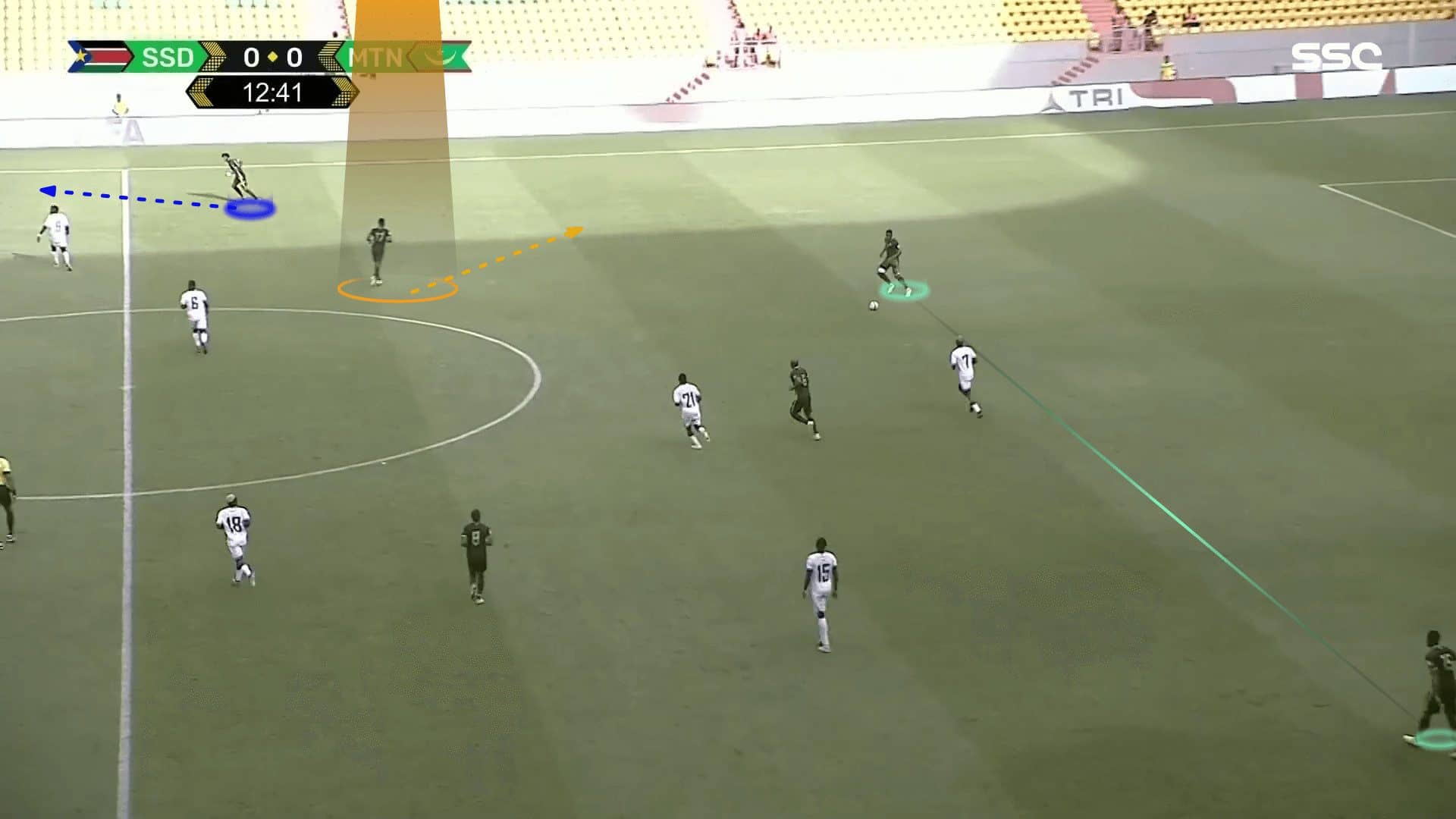
The opponent’s winger is indecisive because he faces two choices: to press the advanced midfielder with the ball or to retreat all this distance with the full-back. What exacerbates the difficulty of the situation is the movement of the Mauritanian winger inside next to the striker to pull the opponent’s full-back as far as possible. Hence, the full-back is perplexed because they create a numerical superiority over him in a 2-v-1 situation.
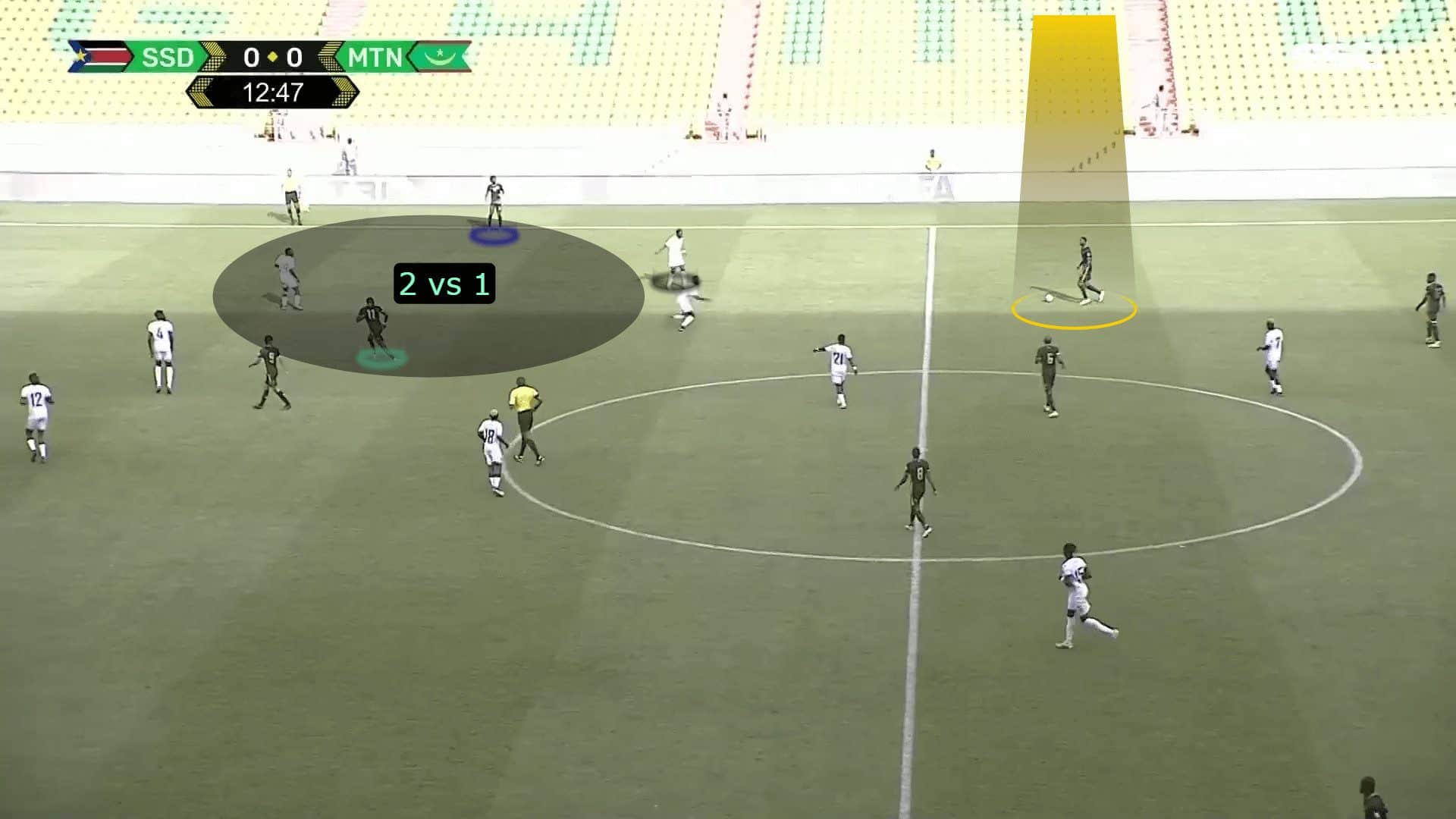
The midfielder passes the ball directly to the winger, who passes the ball to the right full-back in the empty space, as shown below.
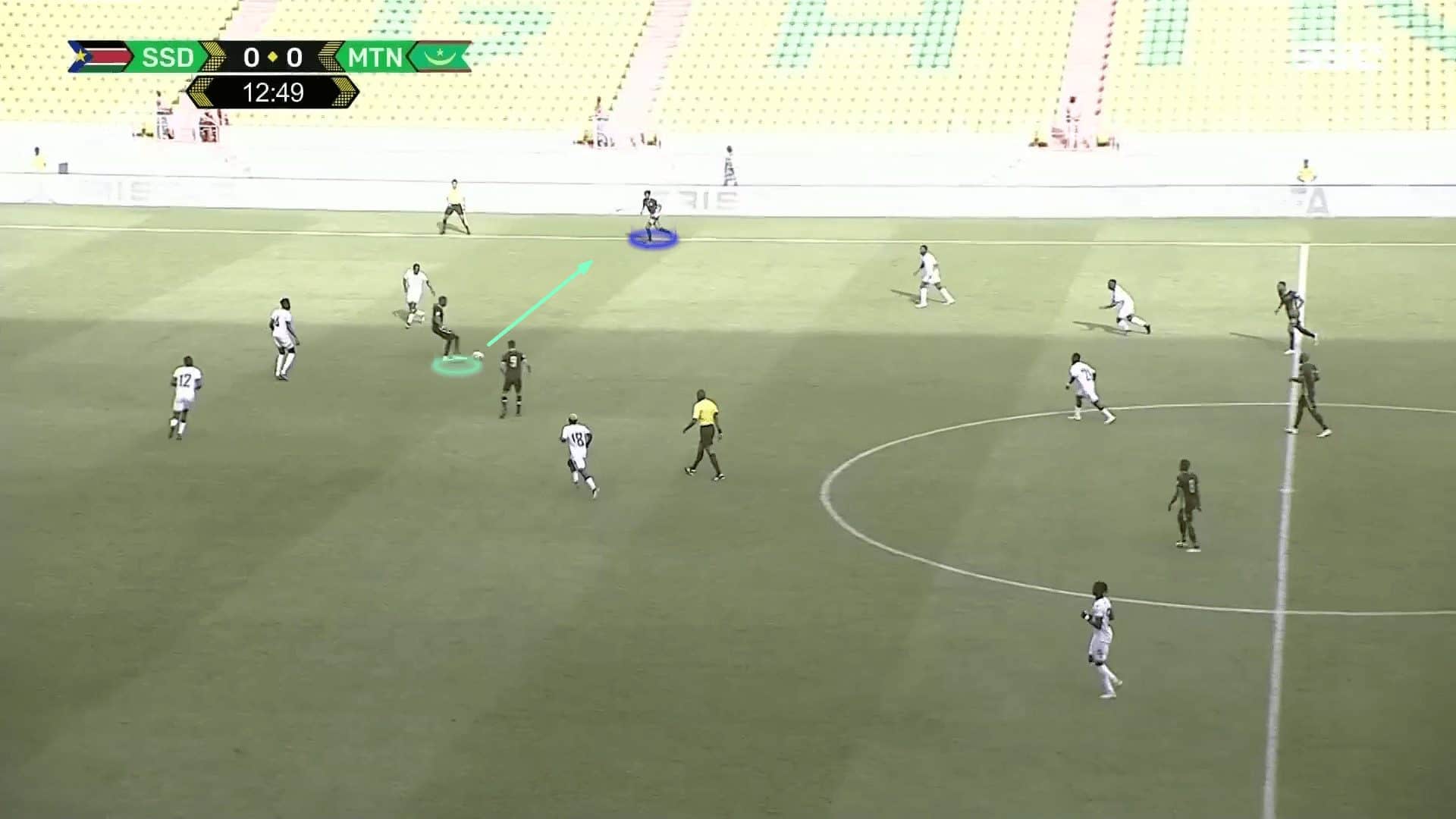
Here, we should note that this midfielder, Abdallahi Mahmoud, is an important player who can play as a midfielder, a number 10, or a winger, but he was injured in the friendly match with Tunisia last Saturday. Yassin Cheikh El Welly is called to join the team instead of him. The same ideas will be presented by the other midfielders, but the problem here is the flexibility of implementing those ideas.
We see in the example below that he dropped in the same area to receive the ball while the full-back was rising above, outside the shot, but when the opponent pressed him, he realised the empty space behind them, attacked it, received under pressure, checked around him to receive in this direction to pass the opponent and pass a through ball to the full-back, as shown in the following two photos.
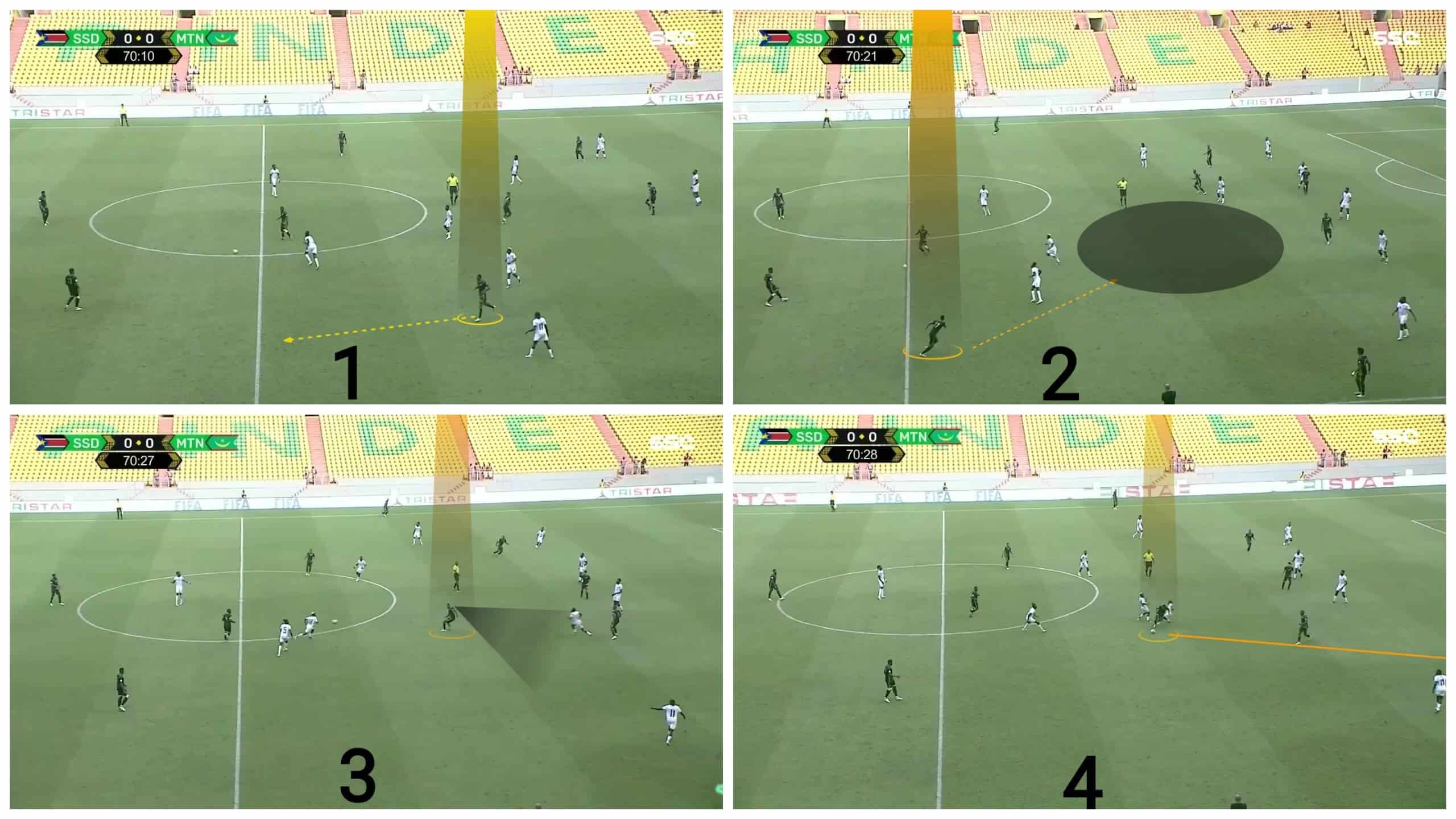
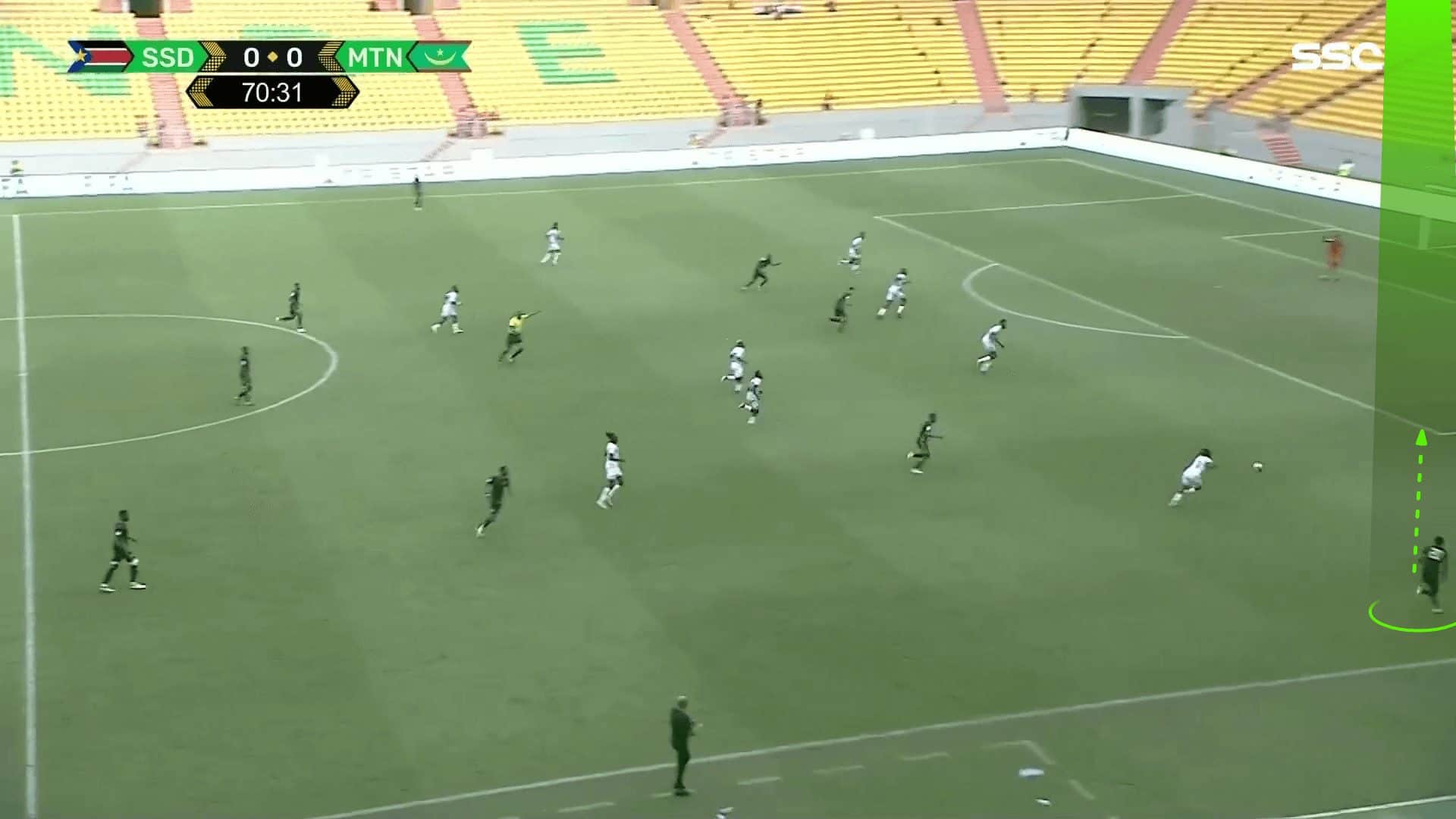
To overload this area, sometimes the centre-back keeps dribbling the ball while the right midfielder, or number 10, keeps narrow to drag the opponent’s full-back, and the right winger, in red below, attacks the box with the striker, as shown in the first photo below.
When the ball reaches the full-back, the right winger moves to receive a cut-back pass while the striker attacks the far post, as shown below.
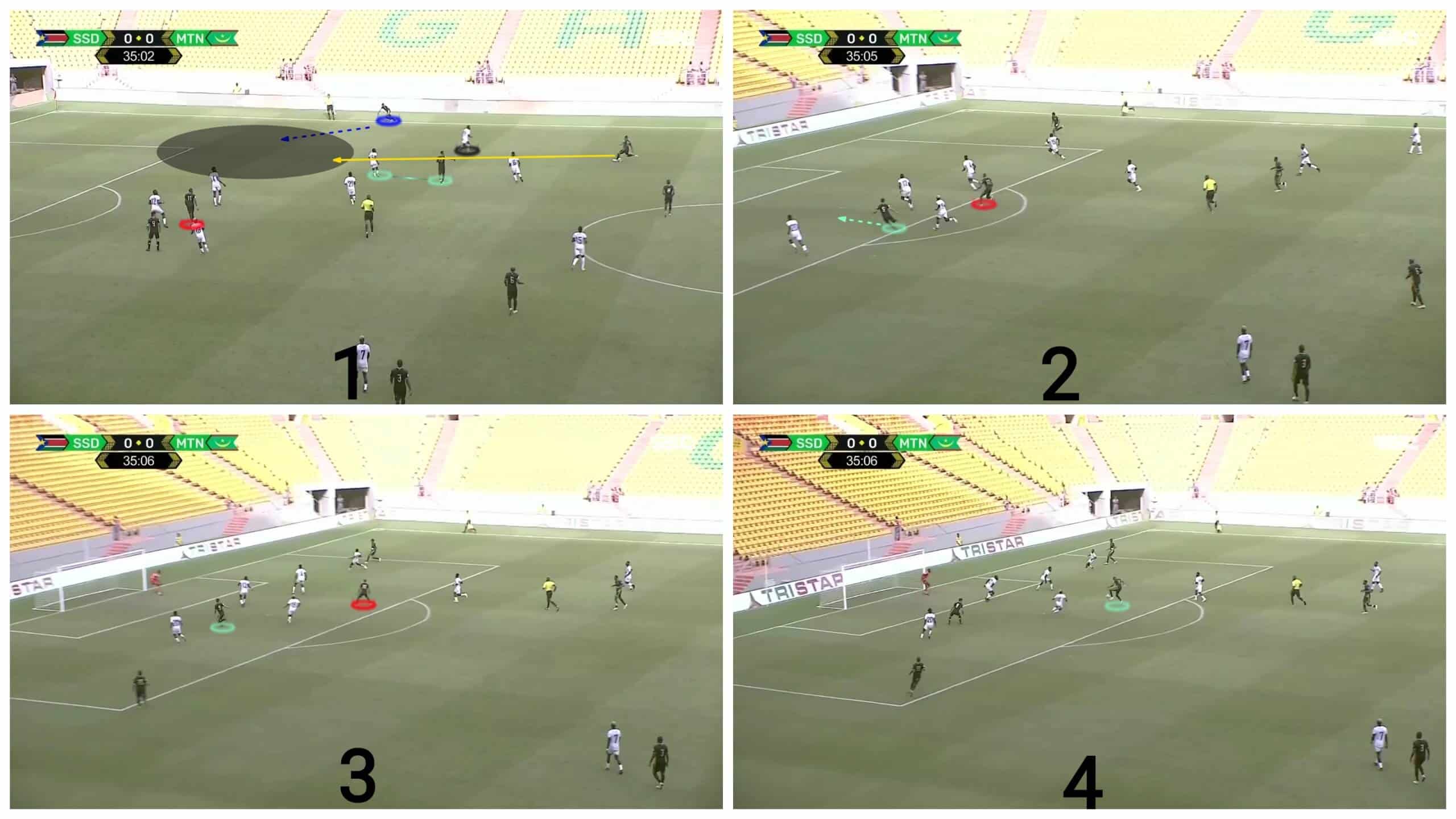
They have another way, which is asking the holding midfielder to drop between the two centre-backs while asking the two full-backs to stretch the pitch and the three players behind the attacker to be narrow so they can pass the ball directly to the full-backs, as shown below.
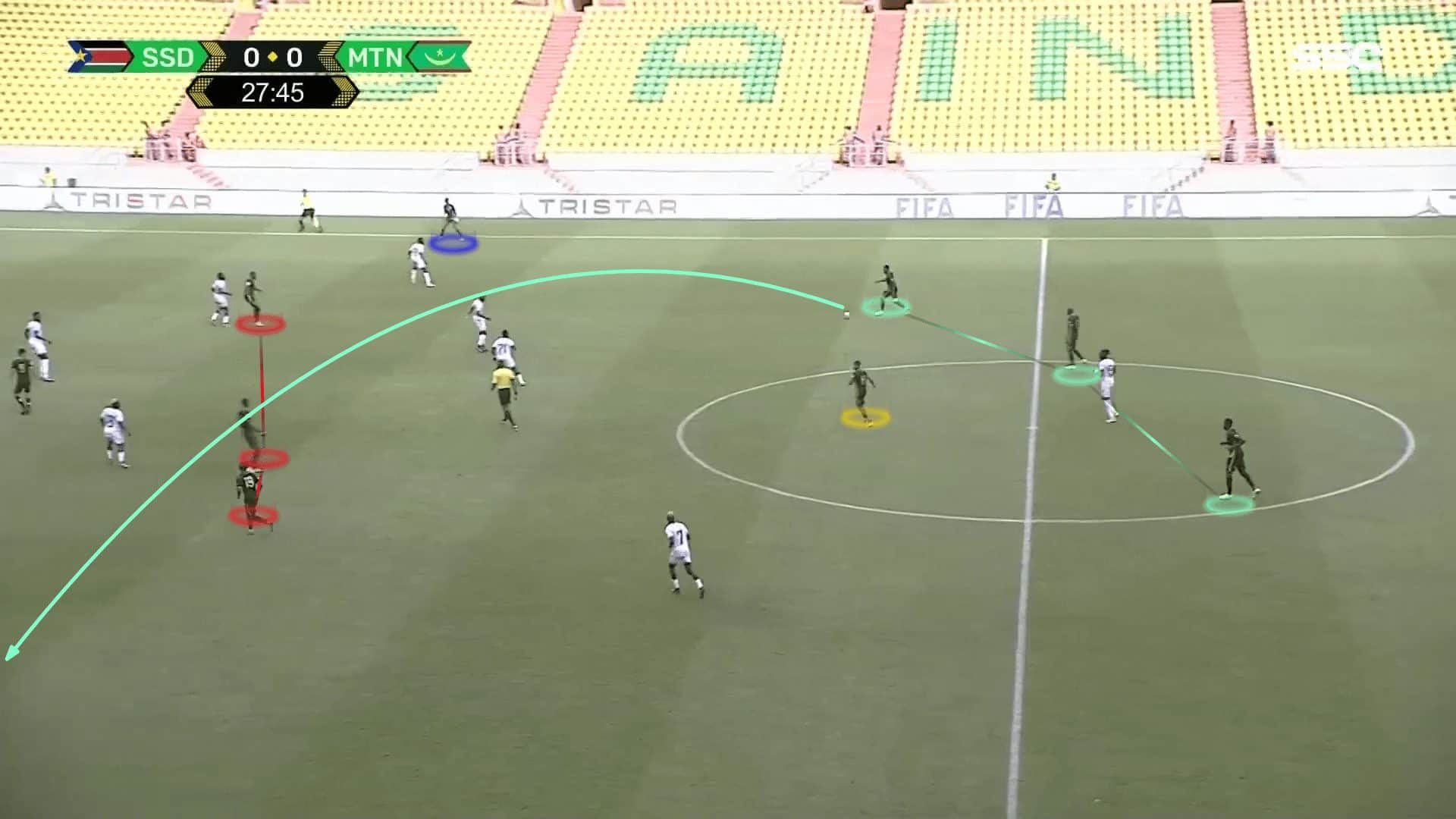
When the ball is in the air to the left full-back, the left winger attacks the area behind the opponent’s full-back, as shown in the two photos below.
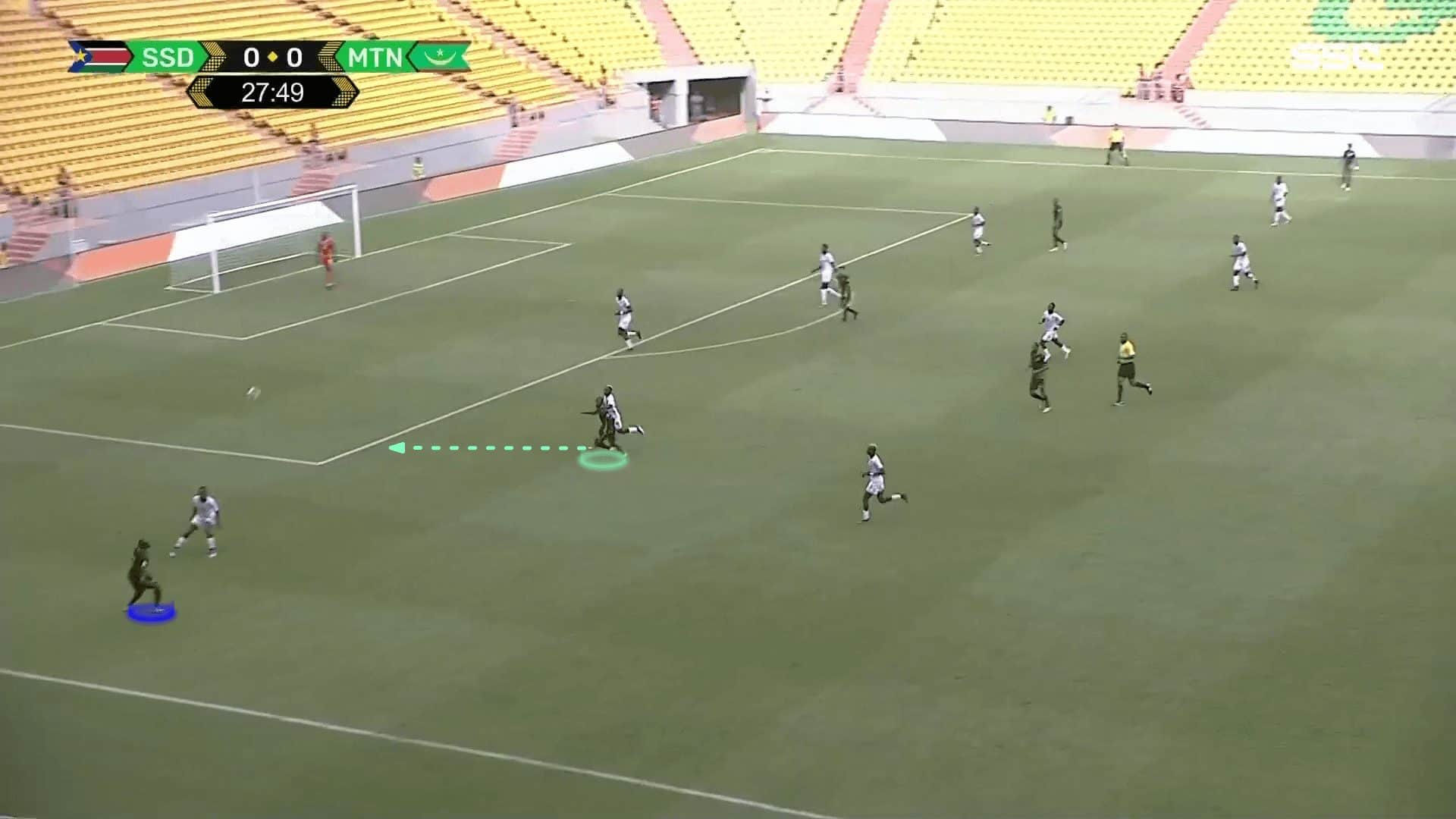
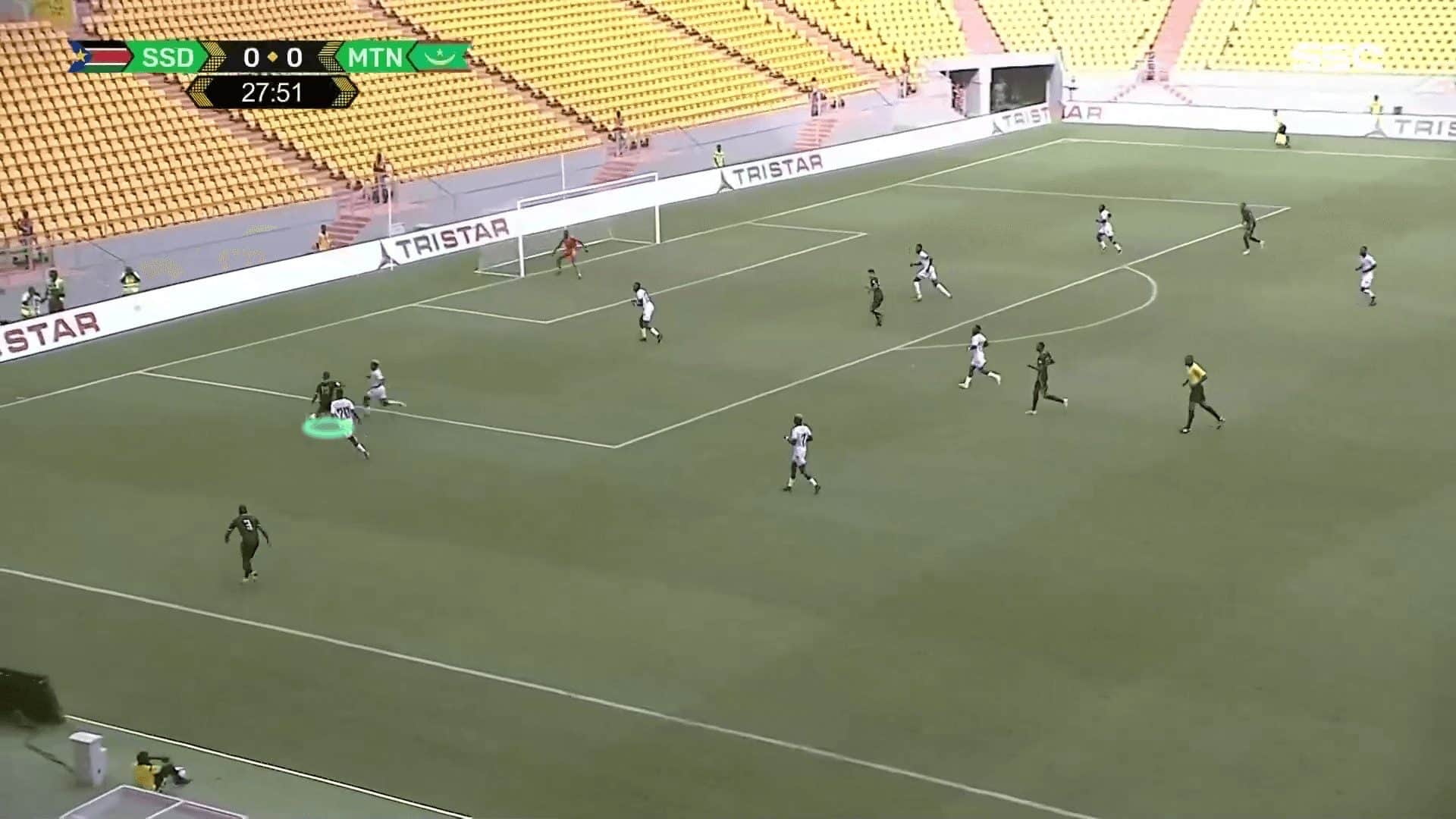
We should also mention how they attack the box by the narrow shape of the wingers mentioned above. In the photo below, the right full-back passes the ball back to one of the two midfielders in a 4-2-3-1 formation. At the same time, the two wingers join the striker in the box, and player number 10 awaits the second ball, so they have an excellent chance to get the header or to get the second ball, as shown in the two photos below.
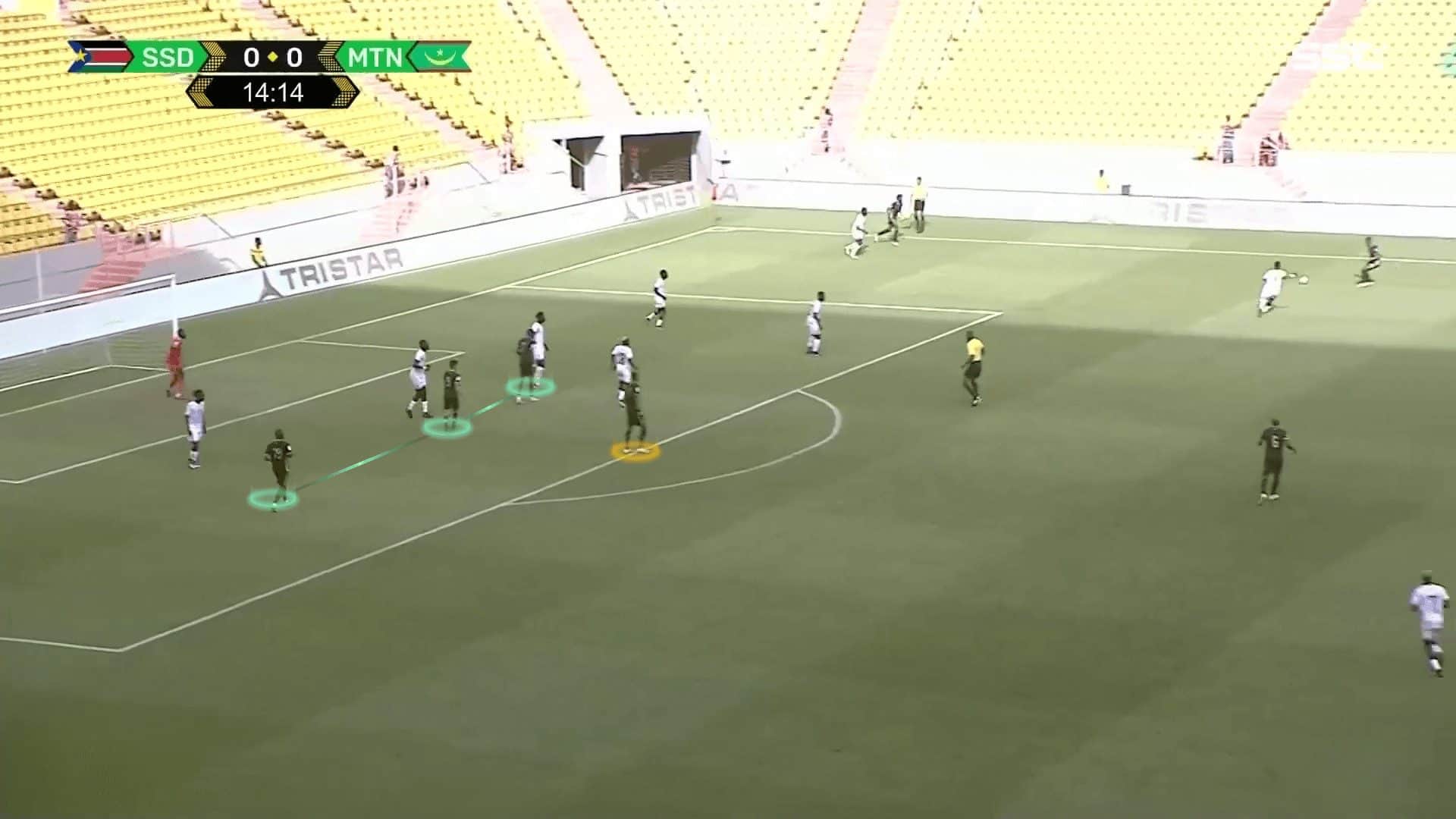
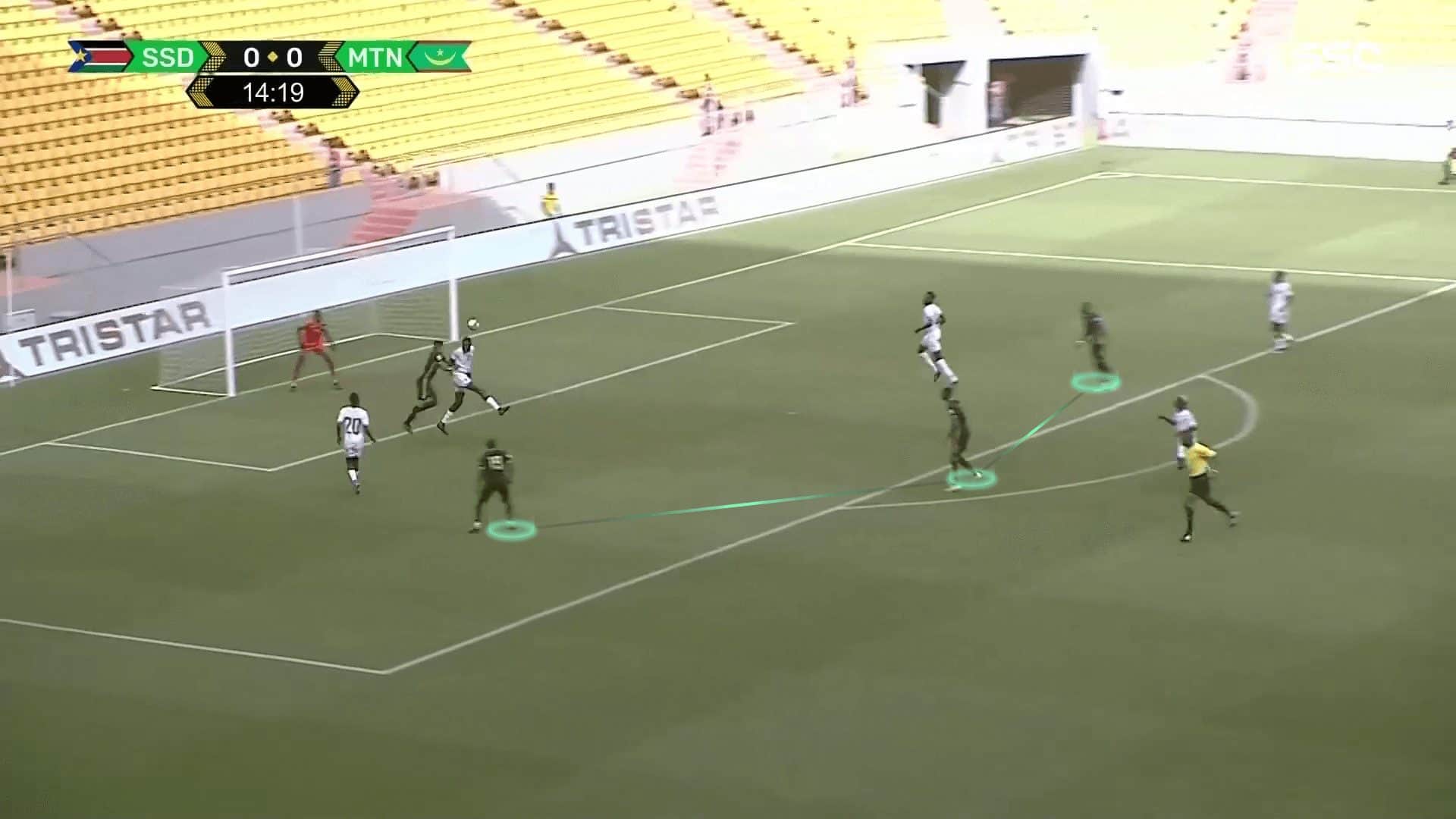
Defending phases
Before we start in the organised defensive phases, we should mention that they prefer to counter-press after losing the ball in the final third, so you can see the left winger and player number 10 pressing quickly toward the ball, as shown in the first photo. In the second photo, one of the two midfielders comes quickly to press behind them while the left full-back joins them; in the third photo, and the other midfielder and the left centre-back cover behind them, as shown in the fourth photo, so the attacker is forced to pass the ball wrongly.
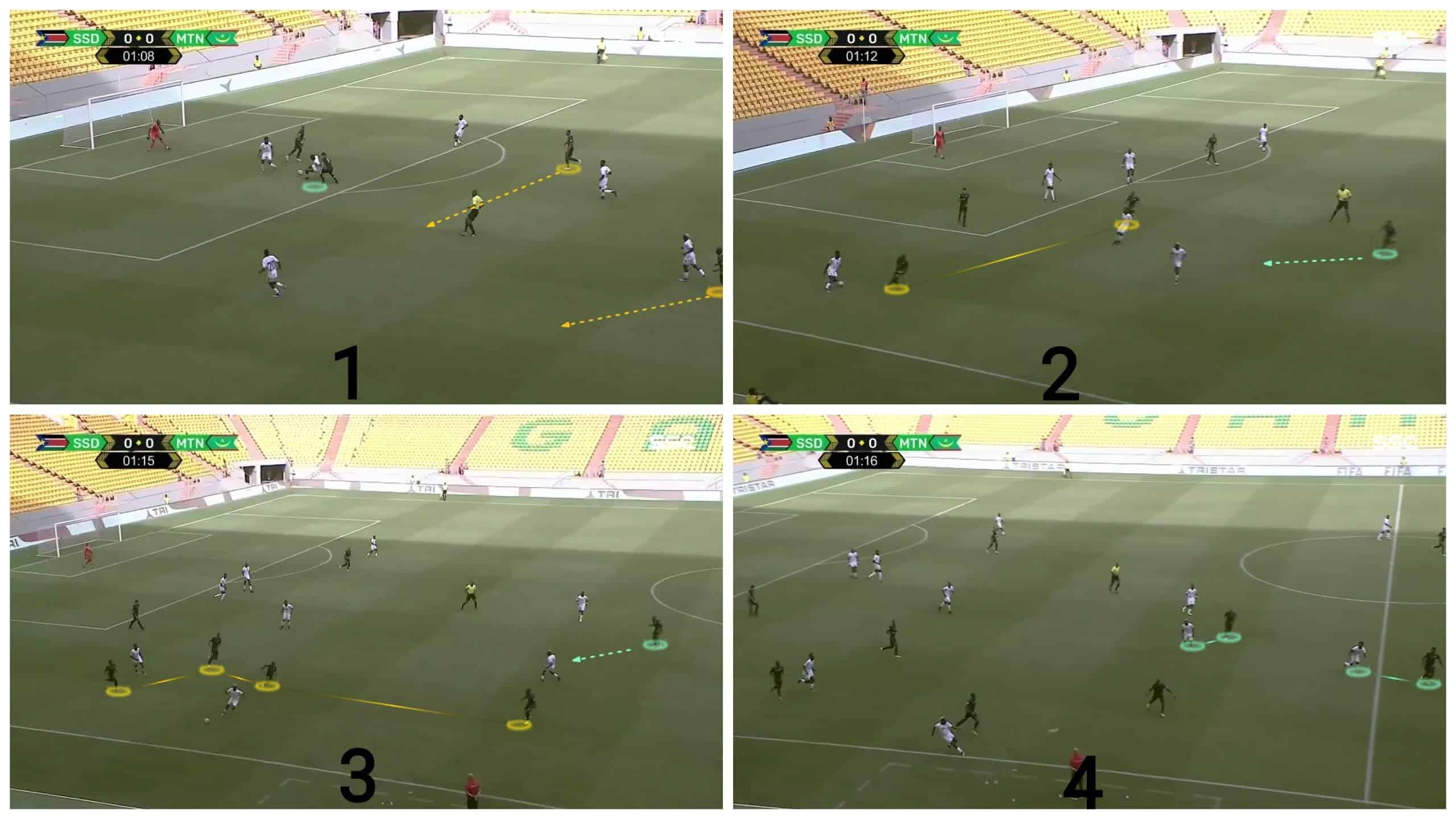
Let’s start with pressing highly when they prefer to implement the side pressing by asking the striker to prevent the defender from switching the play to the goalkeeper or the other defender while number 10, one of the two midfielders and the left winger press the ball with the help of the line to force the opponent to play the long ball, as shown in the two following photos.
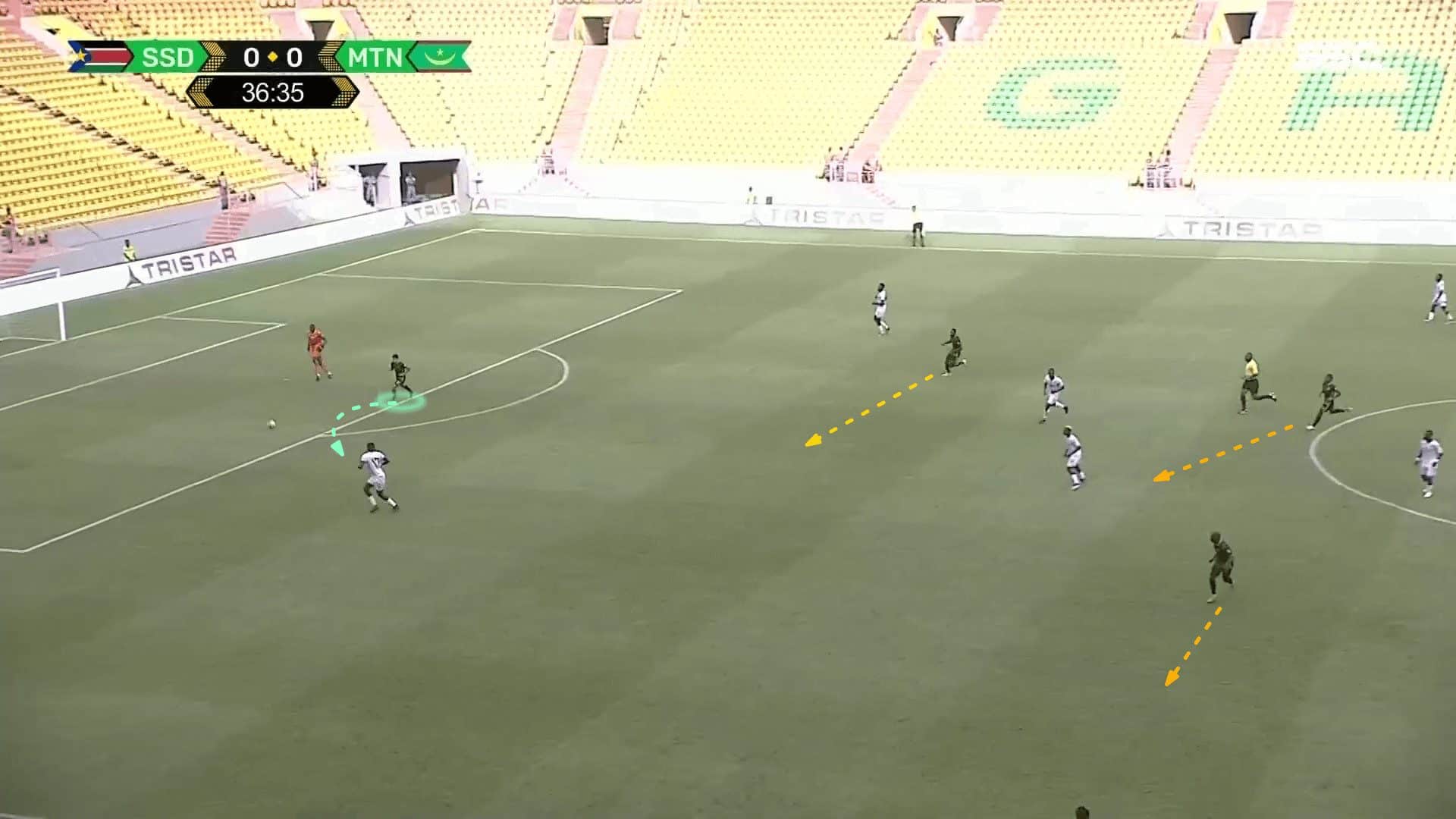
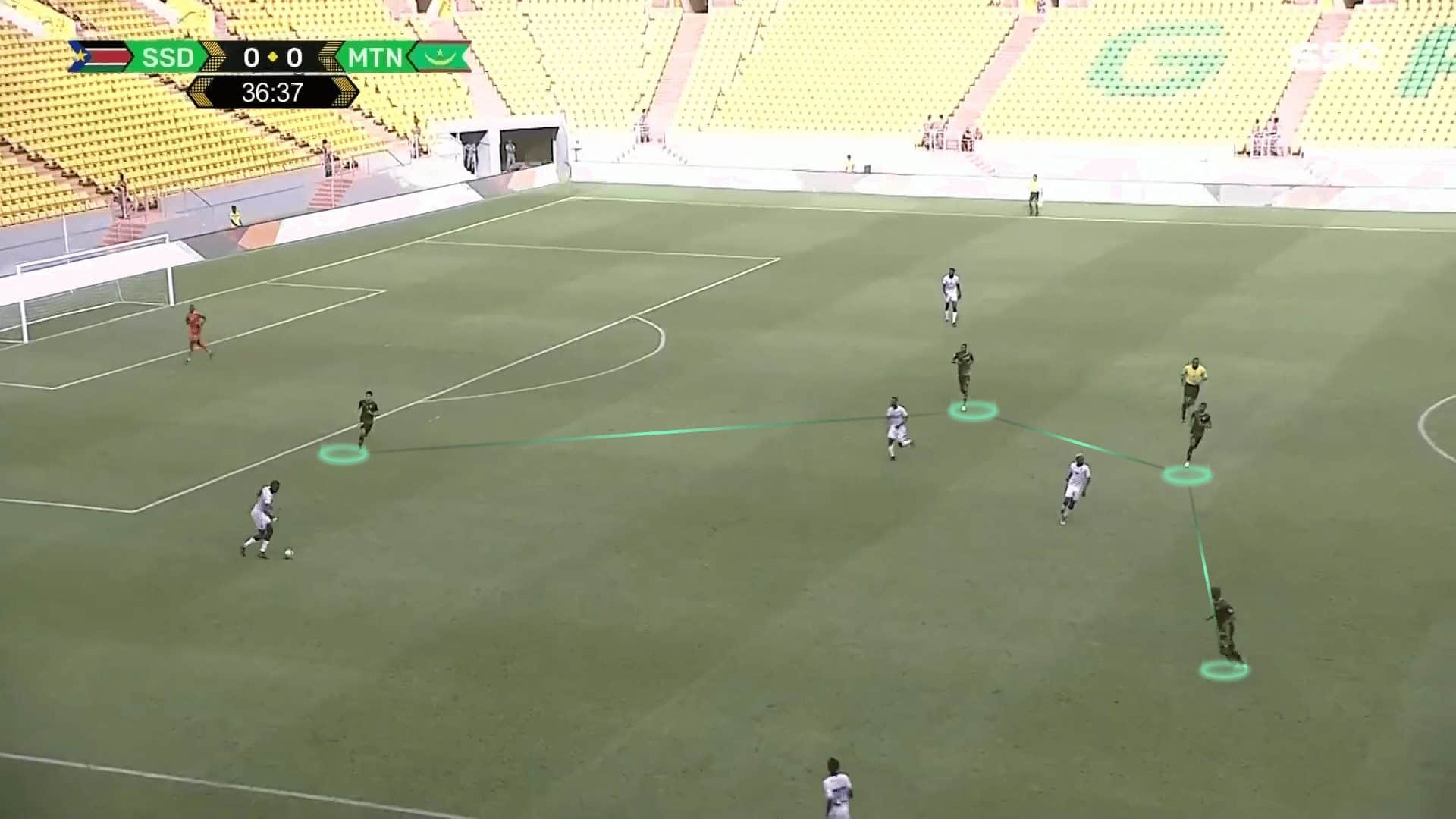
Now we come to how they defend in mid and low blocks. In this case, they prefer to defend in a compact 4-4-2 with a high line, asking the two strikers to mark or cover shadow the opponent’s two midfielders to choke the opponents, forcing them to play the long ball, as shown below.
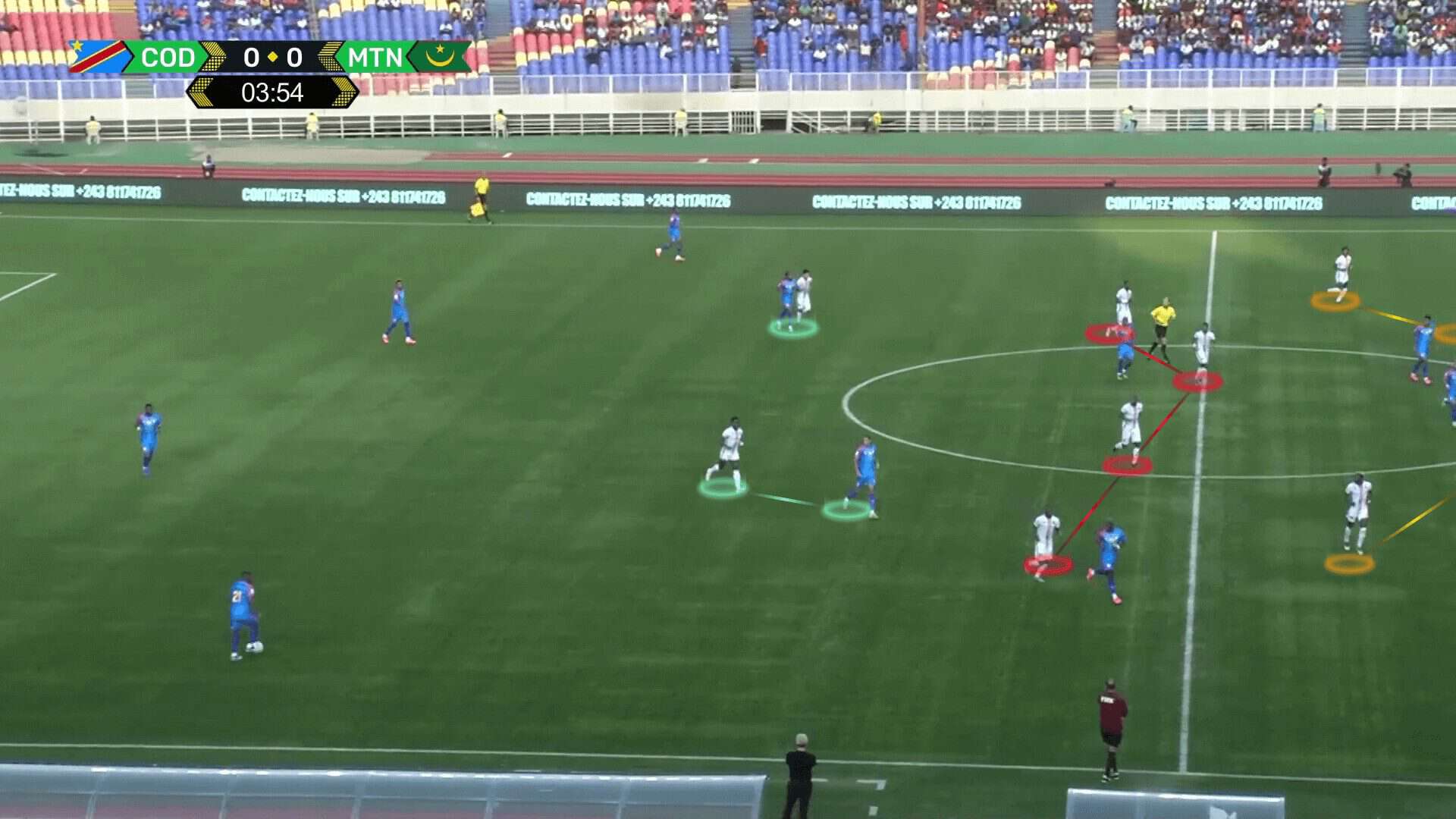
However, opponents found many solutions to get through this defending scheme. The first one is asking the pivot to drop back into the full-back position, as shown below.
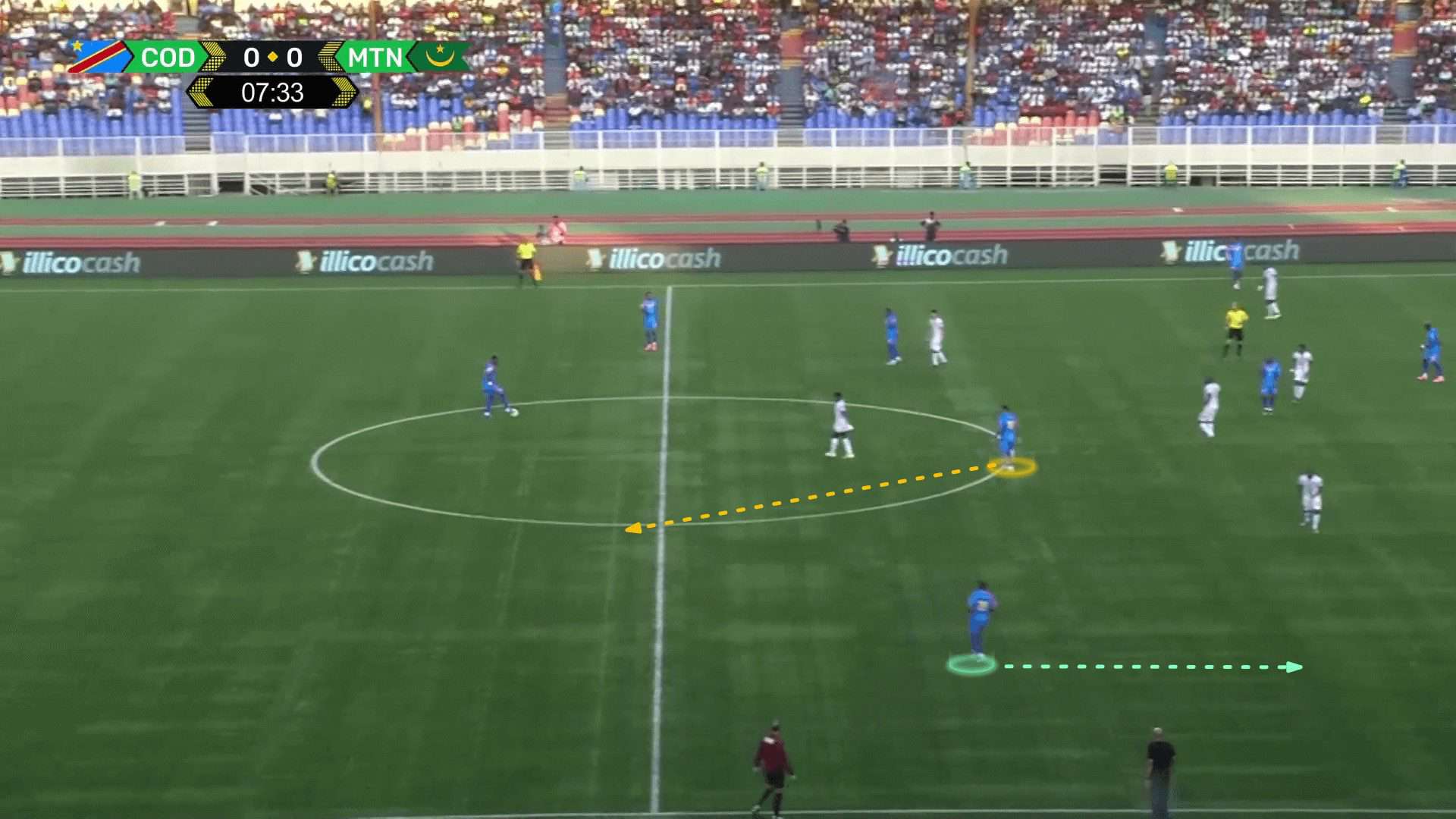
This makes it more difficult for the striker to press the defender while cover-shadowing the pivot, so the centre-back has the time to dribble and get through the defending scheme easily, as shown below.
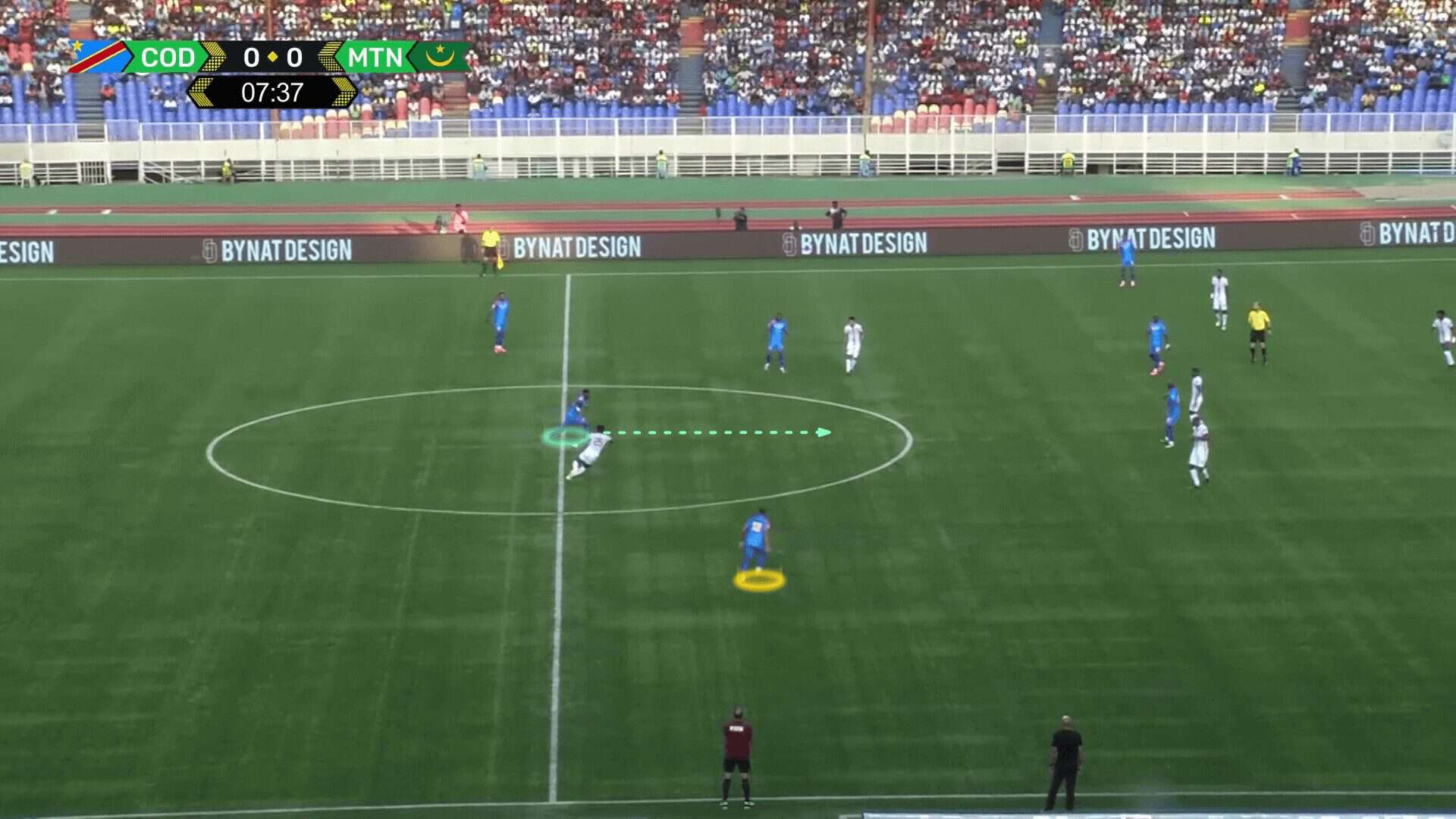
The second way is getting the pivot by a third-man pass. Here, the centre-back drags the striker more and more to press him and then passes the ball to the right full-back, who passes it to the free pivot, as shown in the two photos below.
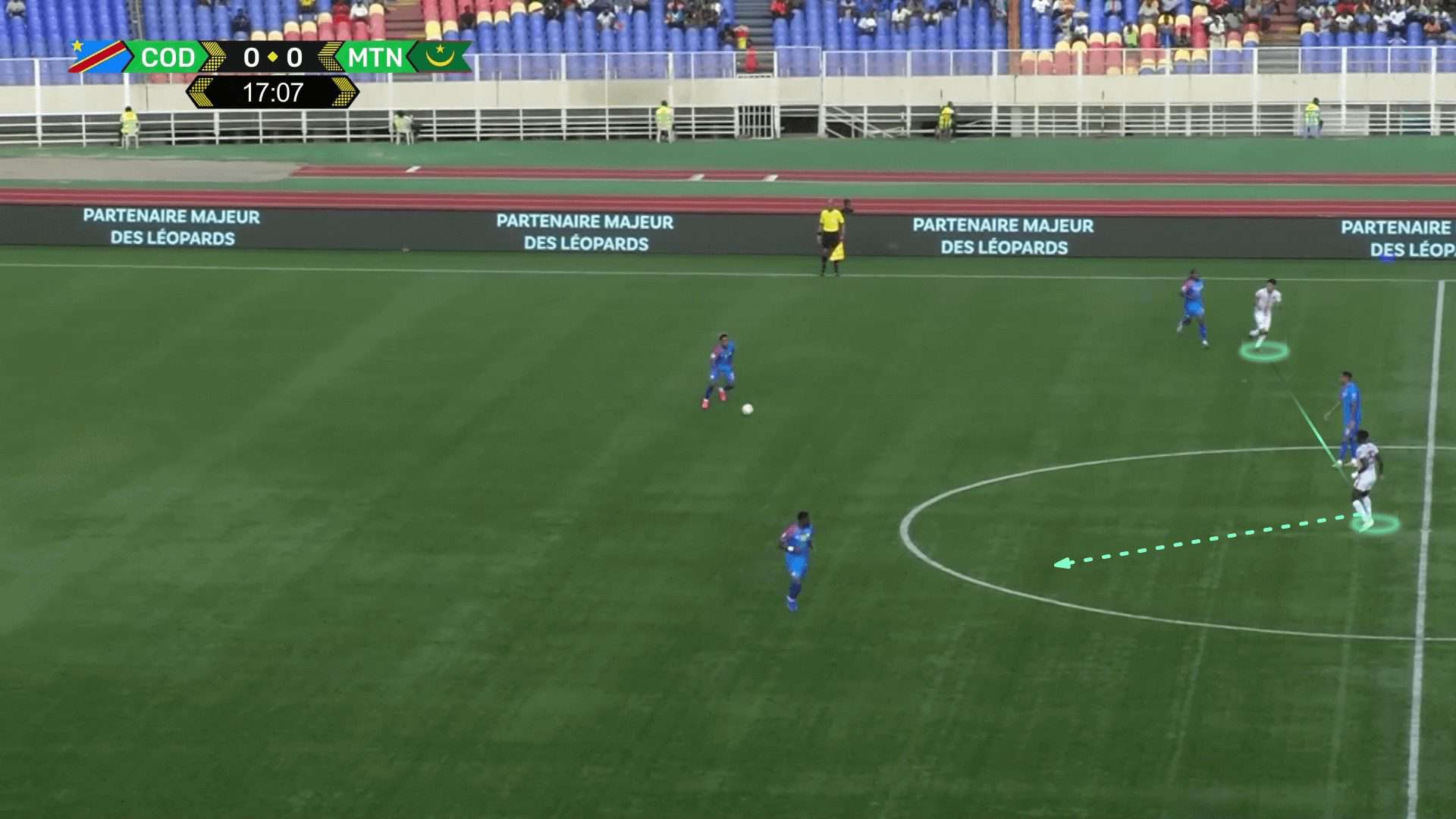
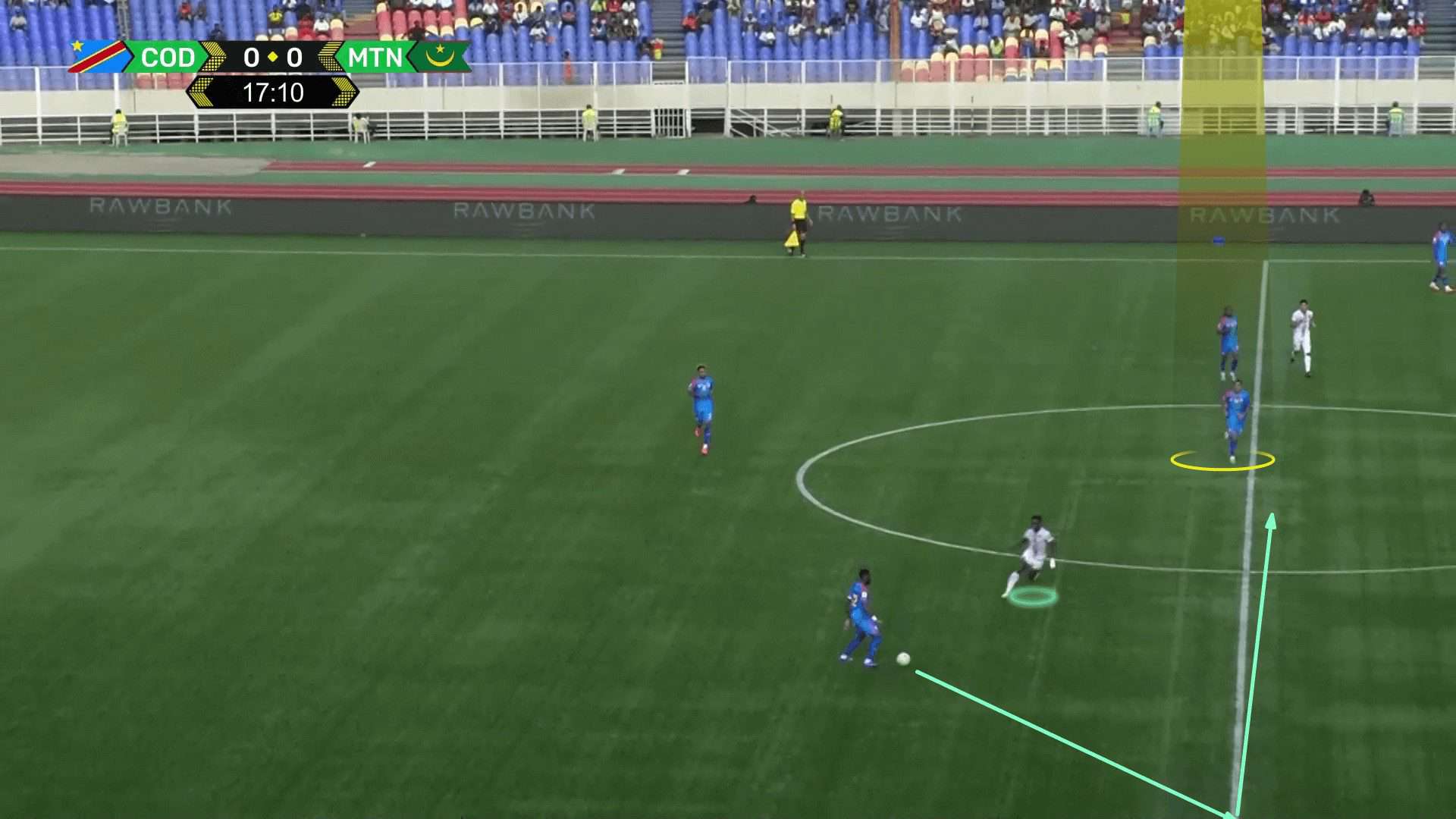
The pivot is free below in a large space, but they were lucky because the full-back didn’t pass to him.

The third one is making the distance between the pivots long to make shifting between strikers difficult, so when the striker leaves his pivot to press the centre-back, it becomes difficult for the other striker to cover him, as shown below.
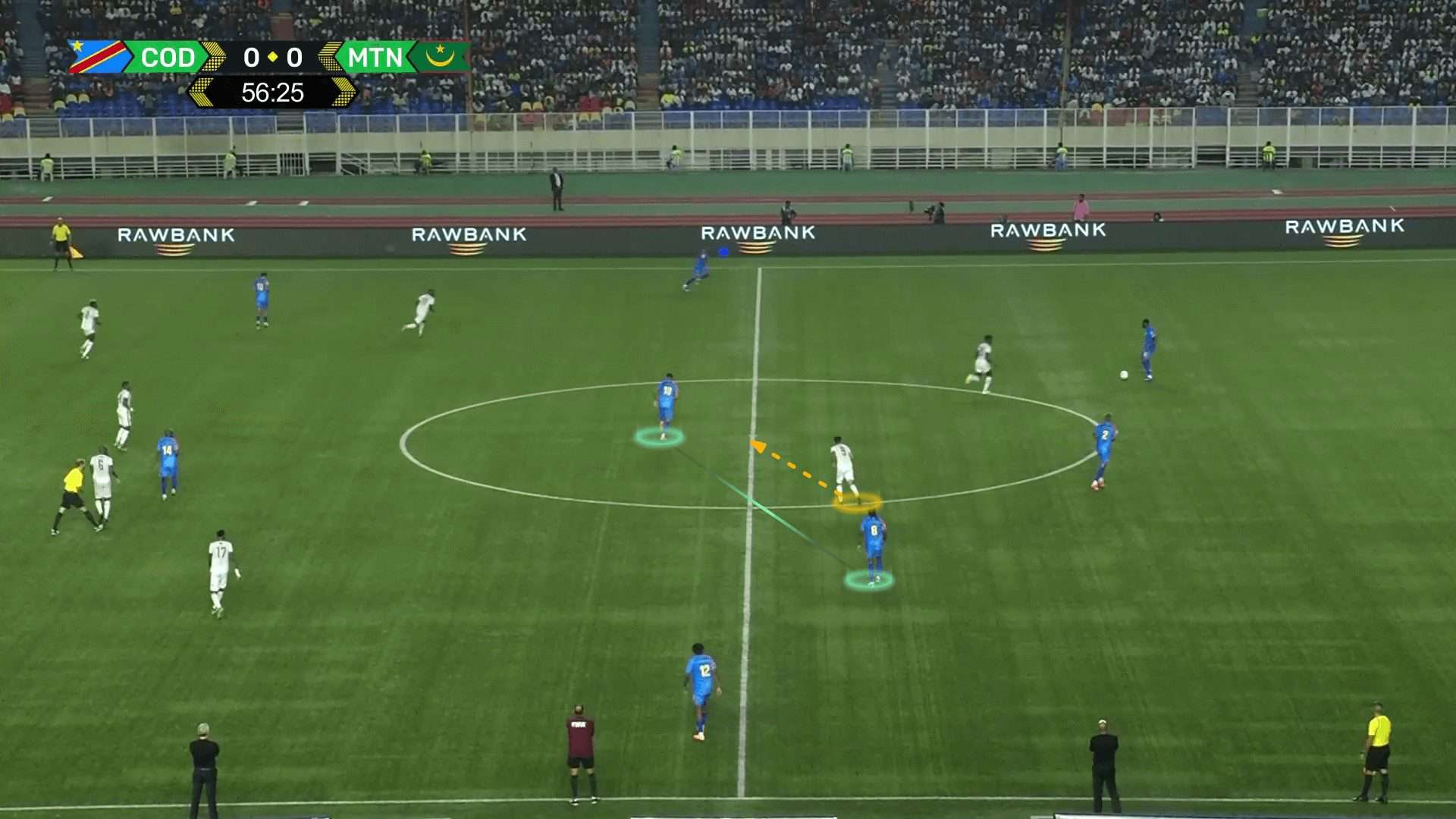
The opponent reached the pivot easily through a pass to the full-back, as we mentioned above.
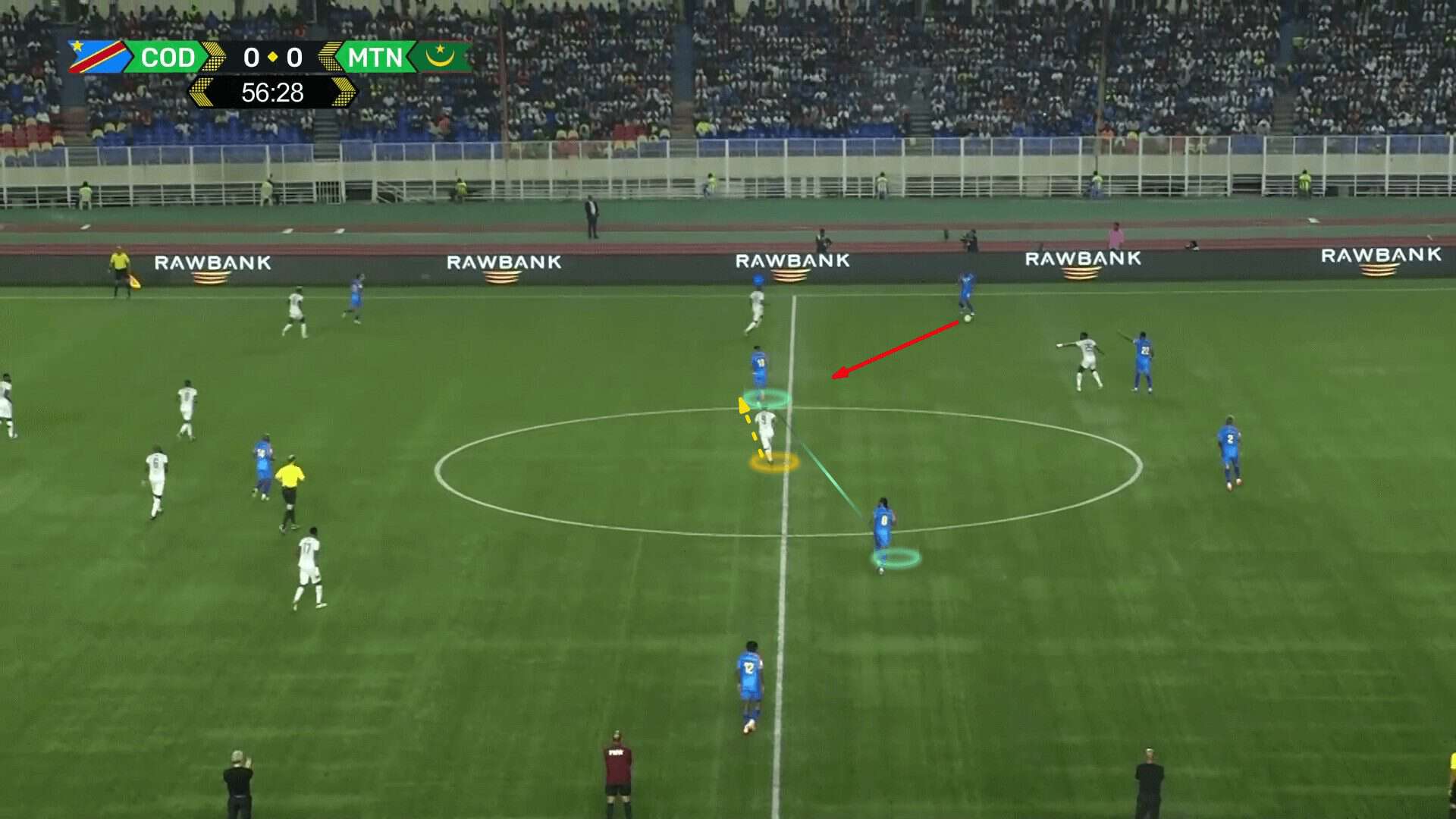
We see that the solution is asking one of the two Mauritanian midfielders to be behind them in a near distance to help in the process of covering and shifting while asking the two wingers to be narrow to make the far winger defend as a midfielder but when they used a midfielder to cover, they implemented the opposite of that.
In the photo below, the midfielder is ready to cover the striker, who goes to press the centre-back.
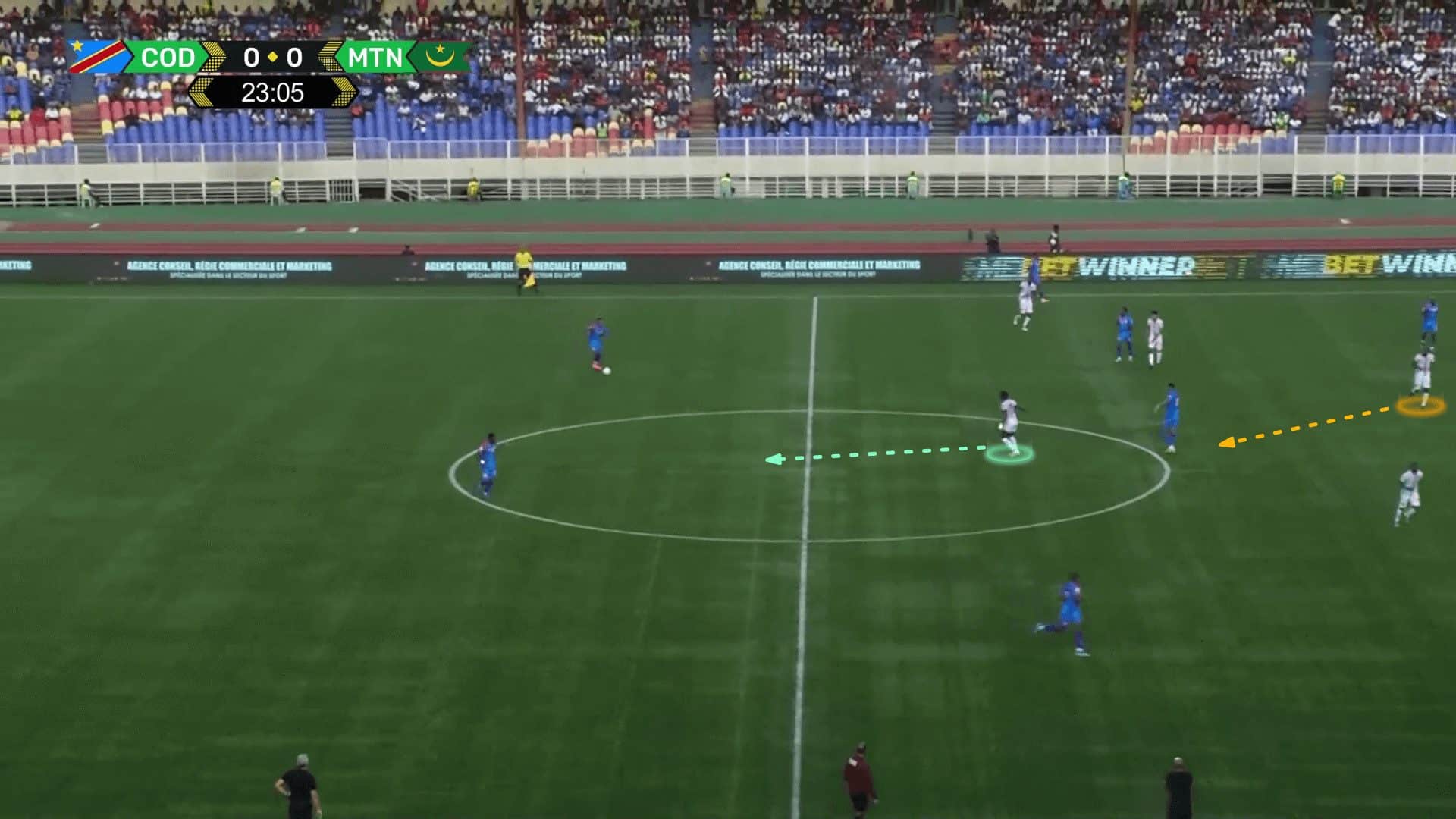
The opponent’s midfielder dragged him widely while the far attacking wing joins number 10 in a 2-v-1 position against the Mauritanian midfielder. The Mauritanian right winger, who should help in the middle, is still far.
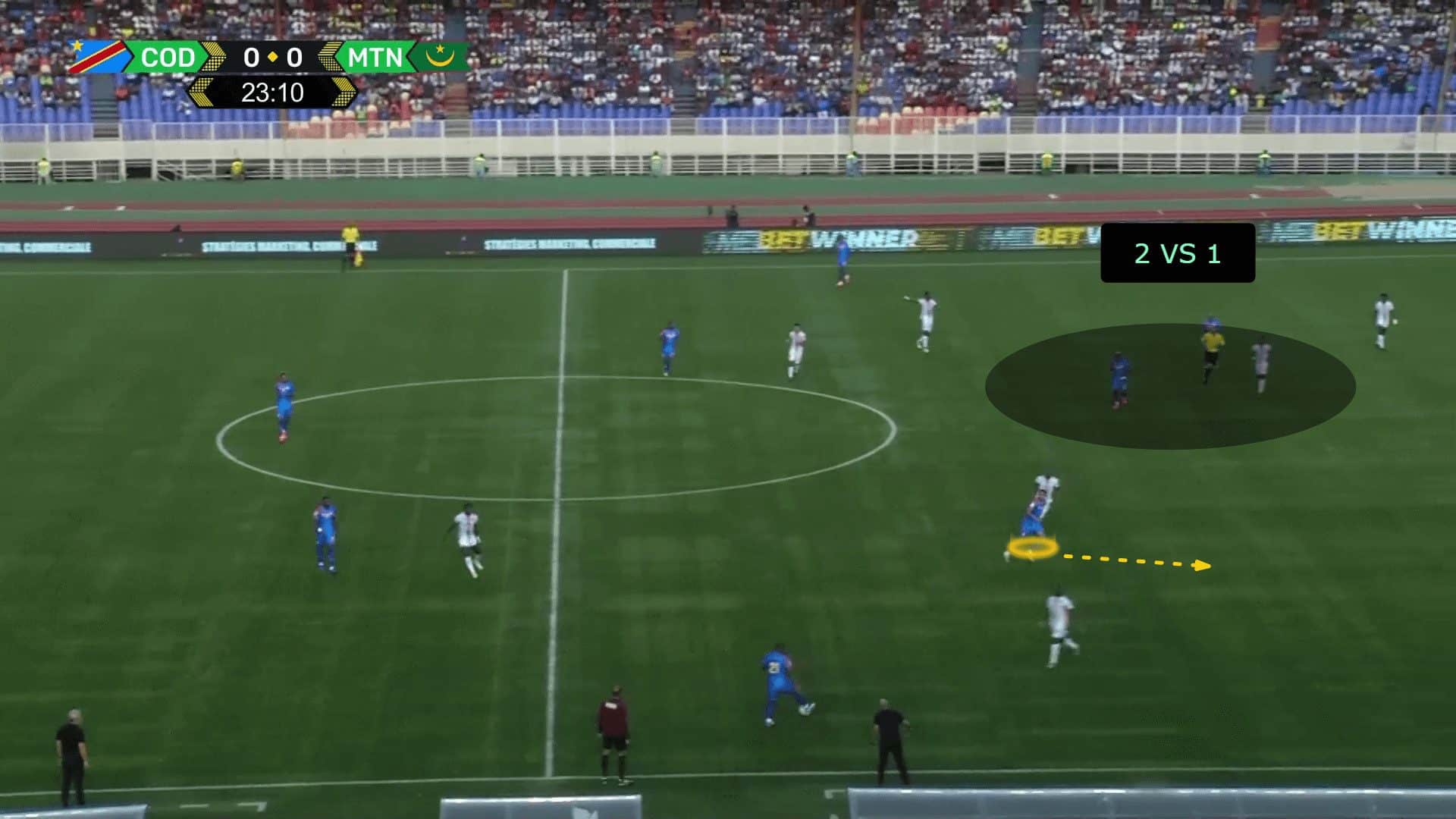
A player to watch
We suggest to follow the Mauritanian striker, Hemeya Tanjy, who is 25 years old. He is the best rising player in the Mauritanian league in 2016-2017. He was also the top goal scorer in the Mauritanian League in 17/18 and 20/21.
Let’s start with his best ability, which is link-up play, so you can often find them dropping between the opponent’s defence and midfield to receive and passing to his available teammates, as shown below.
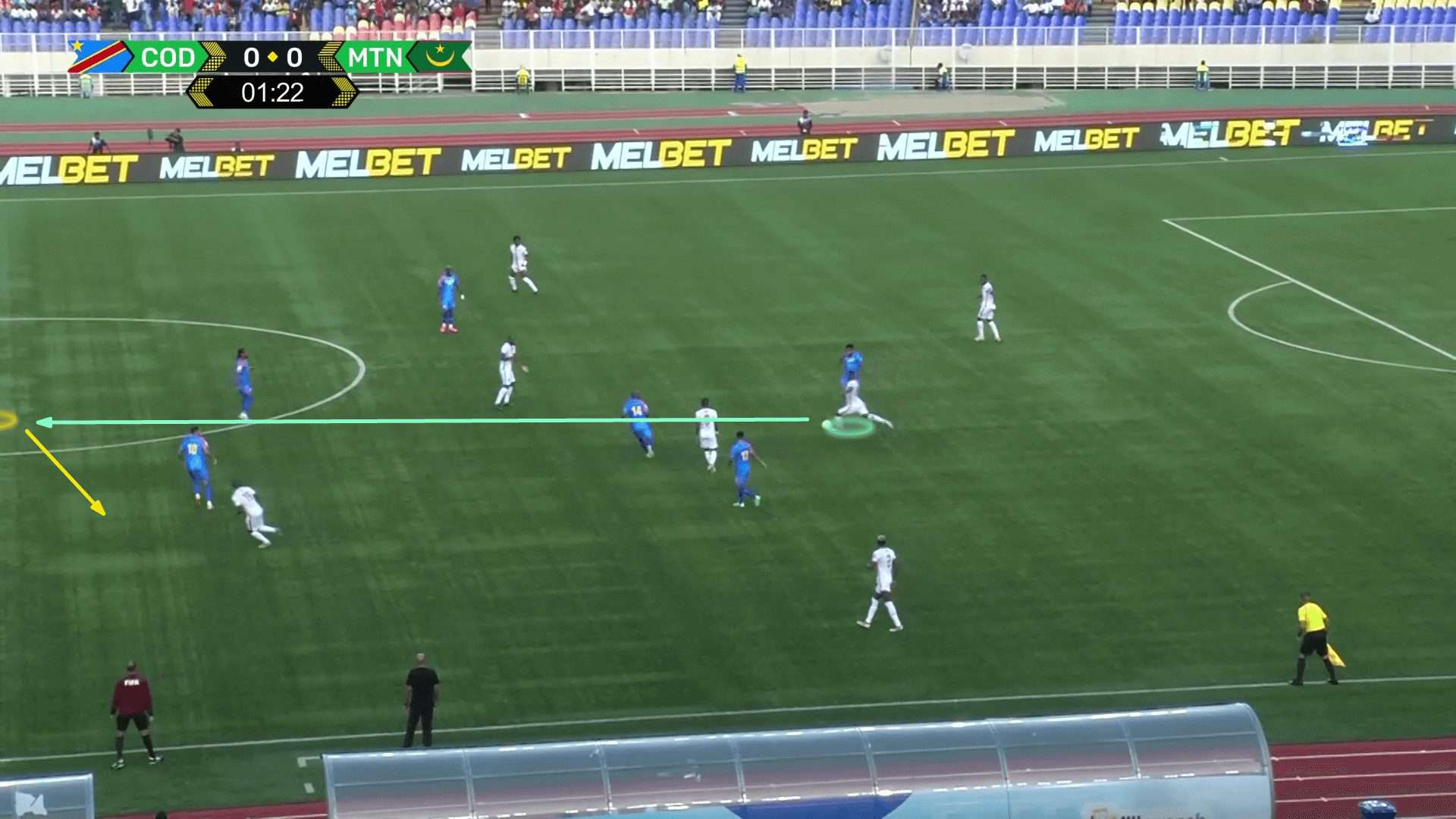
He accurately and quickly passes the ball to his mate by the first touch.
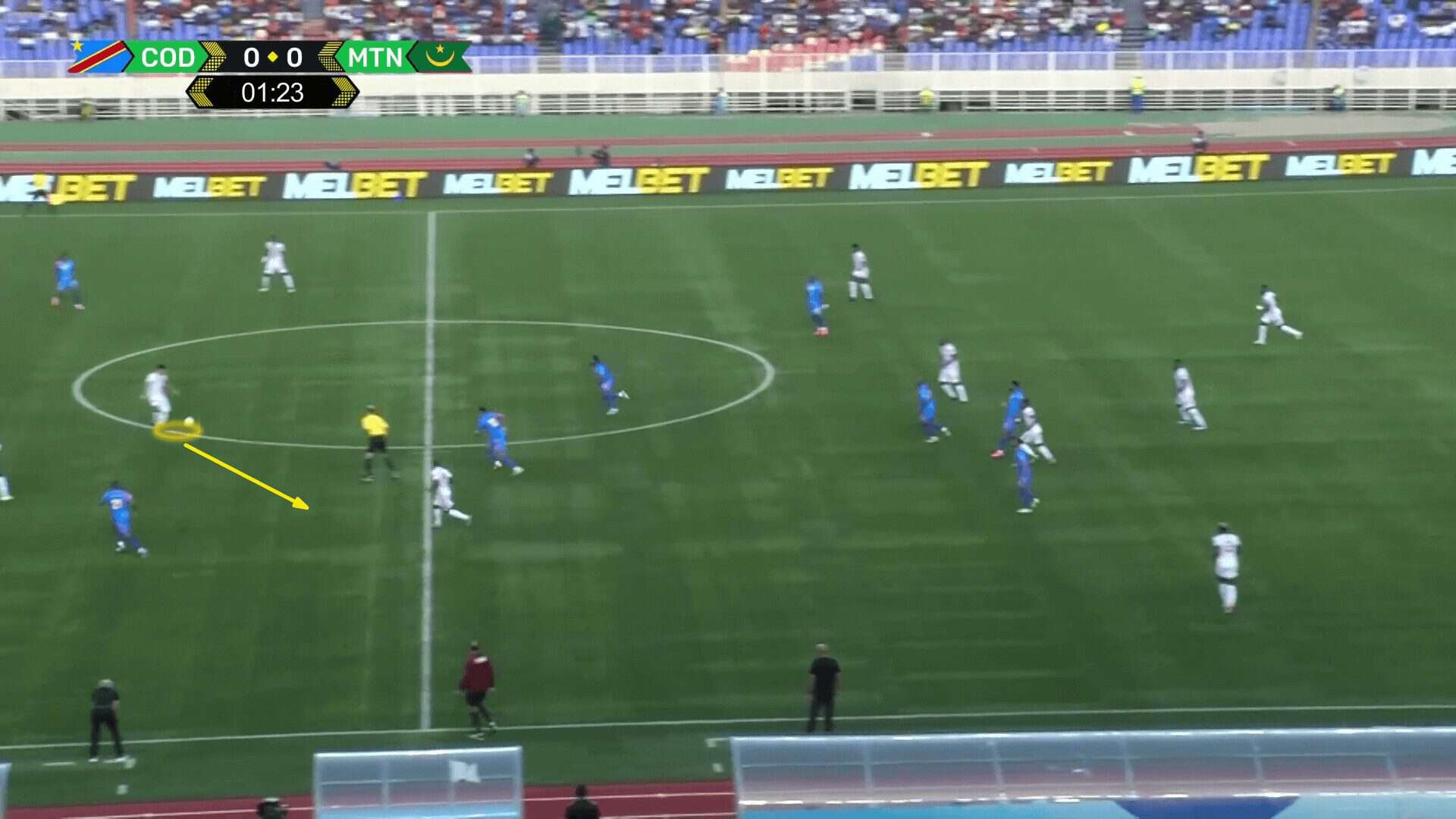
You can find this ability when he changes his position with the winger to receive the ball and help his teammates in progression while the winger gets through the defence coming with his face, as in the case below.
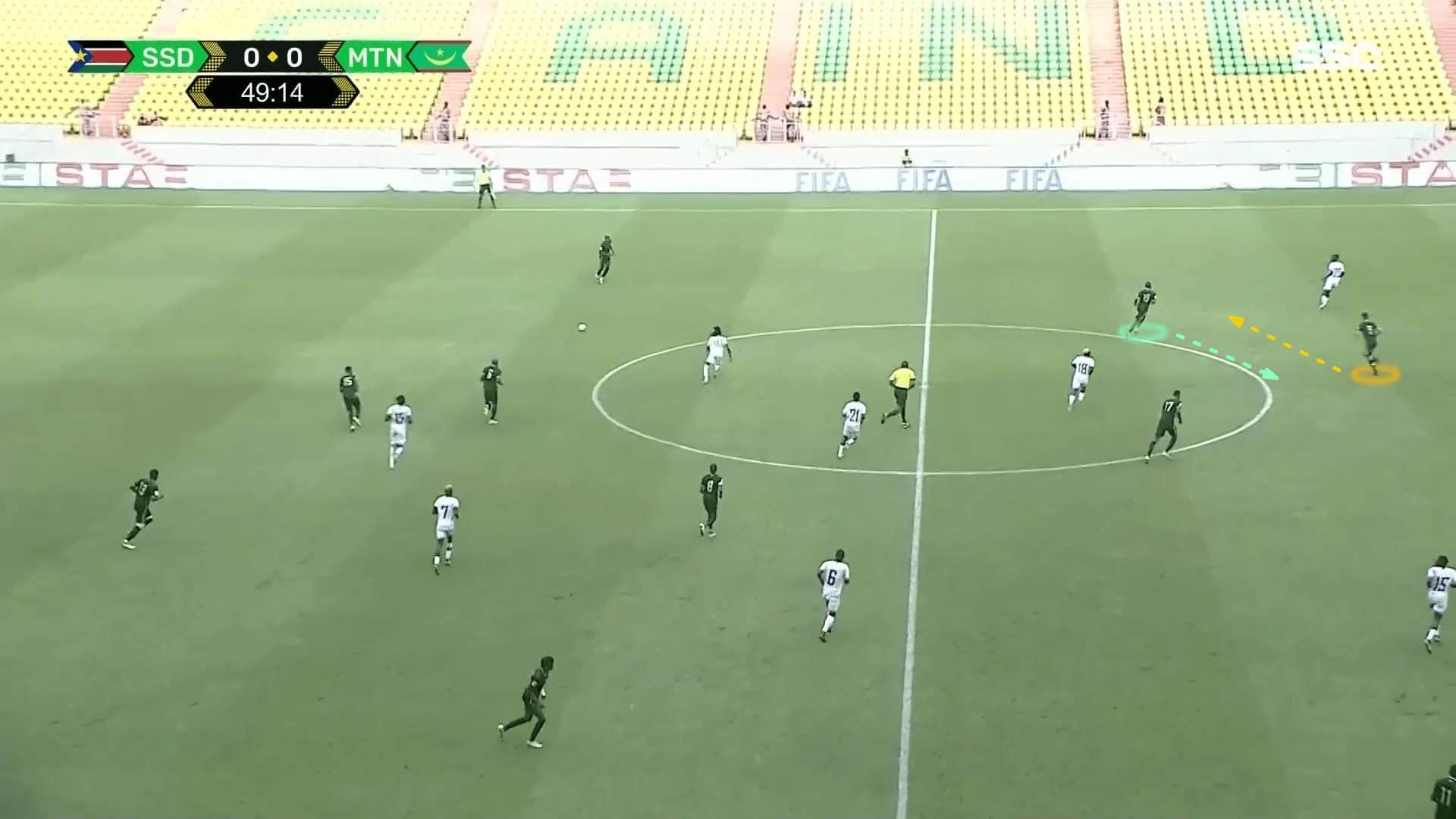
He received the ball in a tight situation, but he got rid of this pressure with a good body feint.
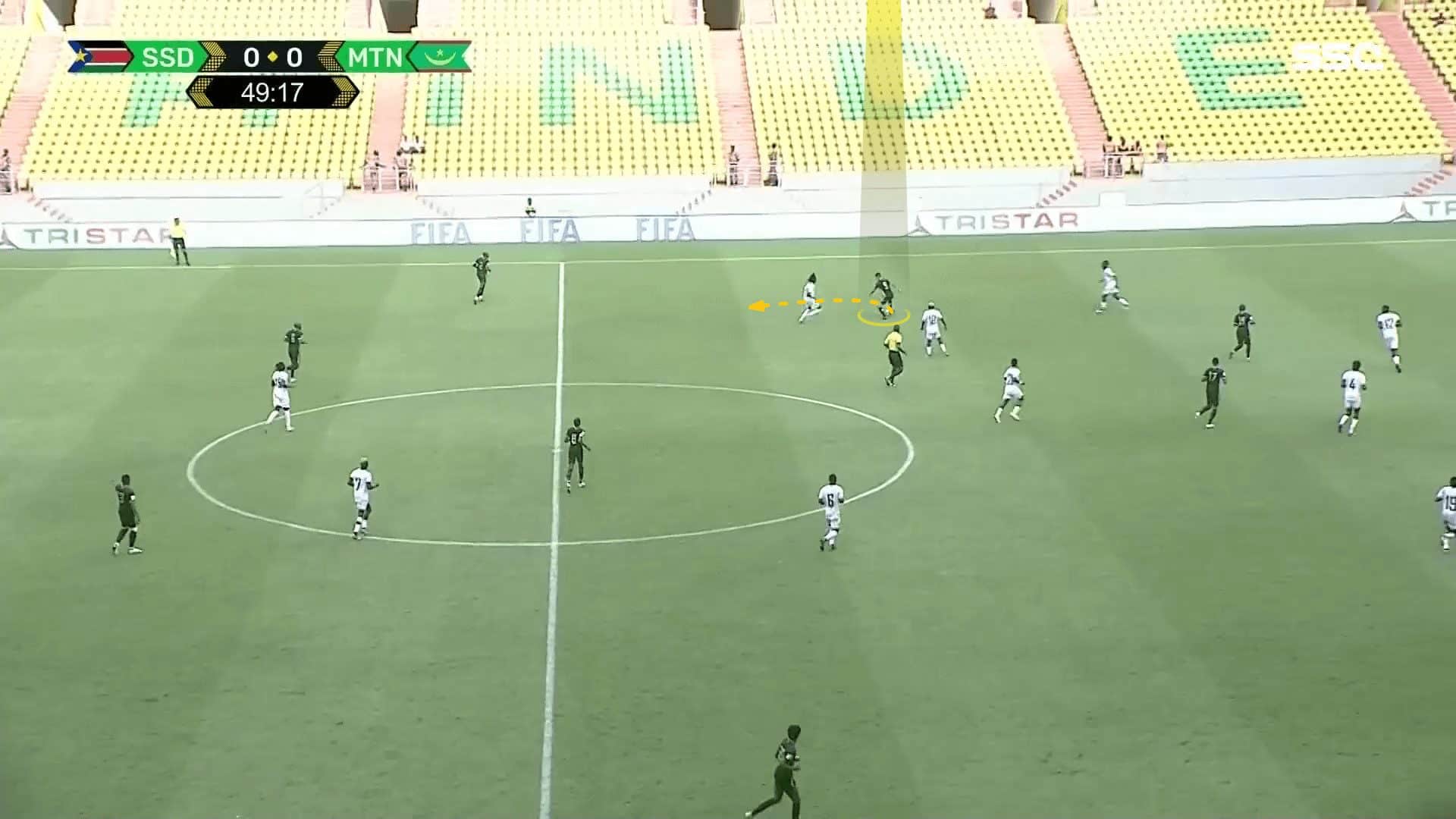
After all of that, he raised his head, watched the right full back stretching the width, and passed a long ball to him behind the defence.
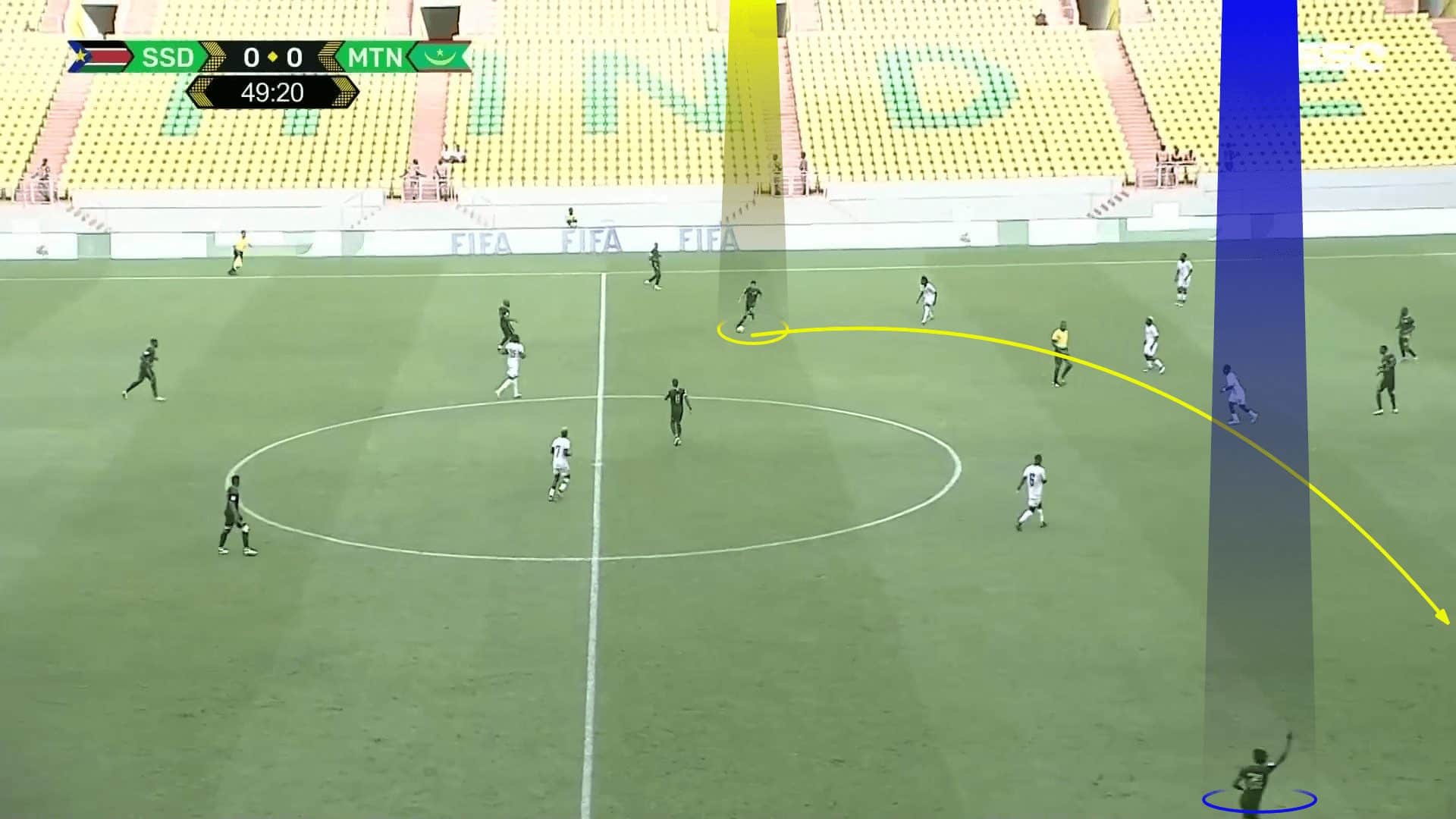
He is always active in opening pass lanes excellently to his teammates, dropping in the gaps to provide help, so he prefers to choose to drop rather than run behind the defence, and this may be a thing he may need to improve to know when to drop and when to run, but it is his type to prefer link up play rather than act as a target man, as shown in the two photos below.
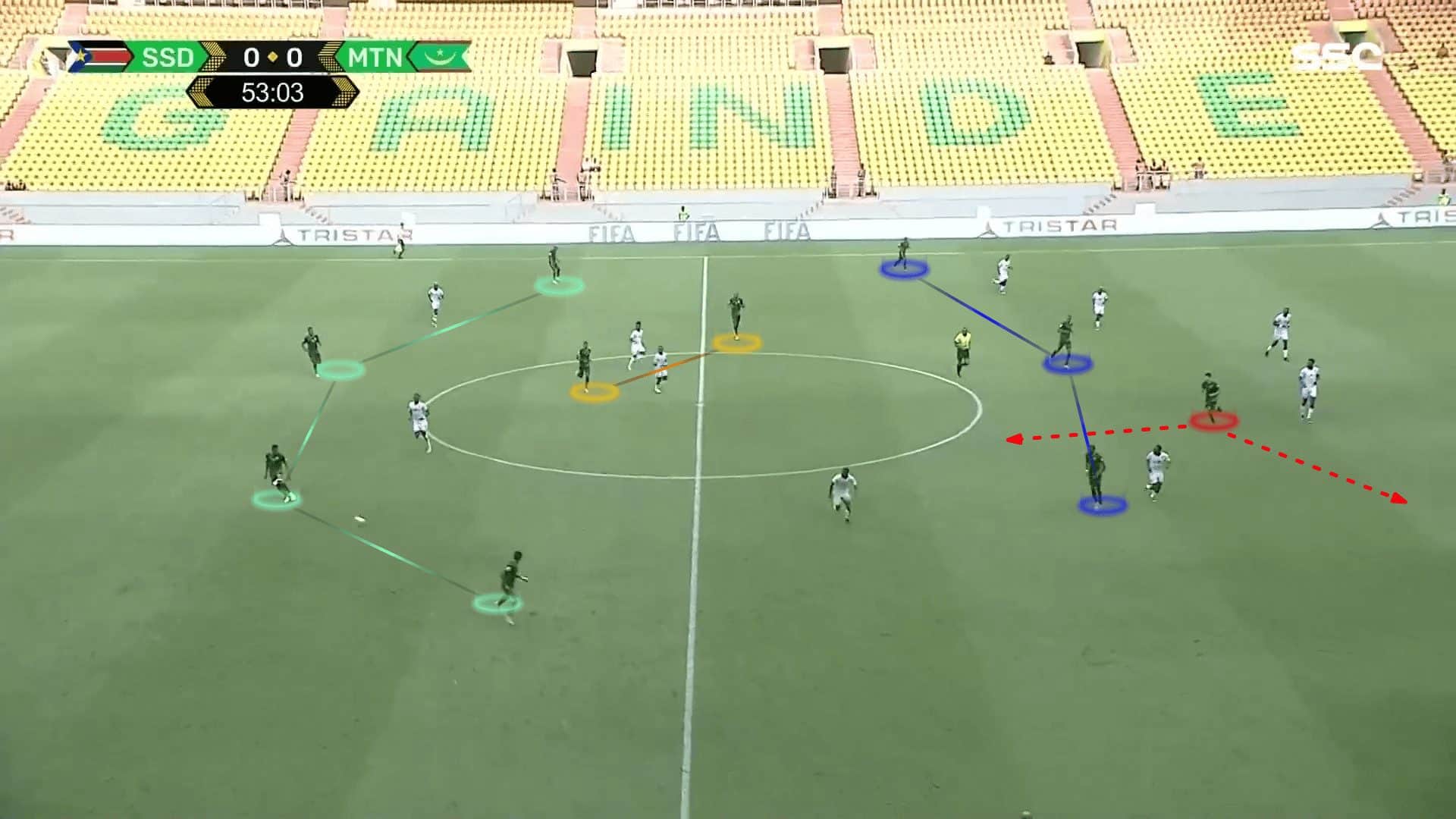
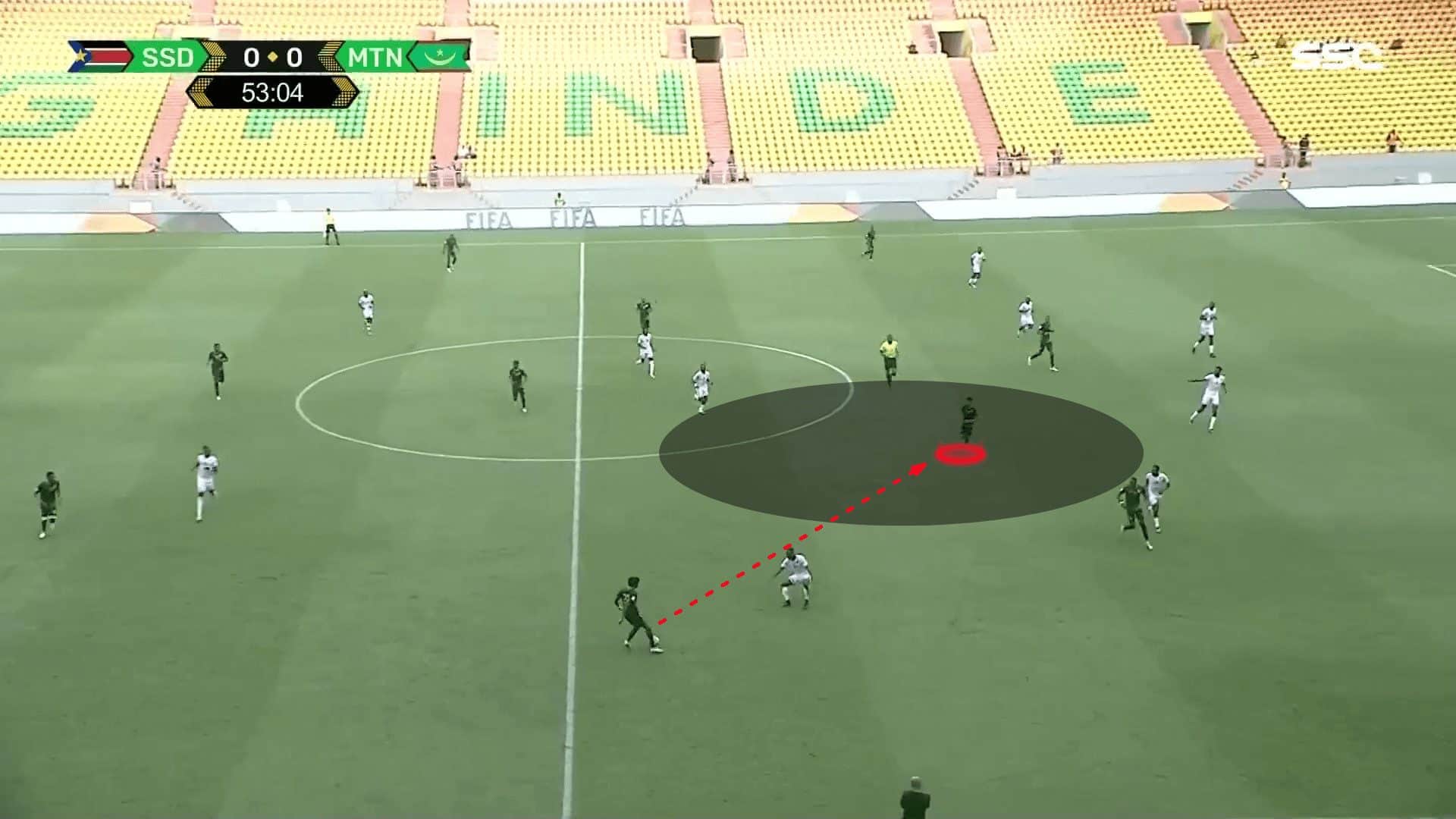
So you can guess he should act as a second striker, dropping to receive while the other targets the box, as in the case below. In the first photo, a defender passes a long pass to the winger, and you can see that he dropped to receive directly from the defender, but it is no problem for him to go to the winger to be a pass option while the other striker runs behind the defence, as shown in the second photo.
In the third photo, his unique awareness is clear, so he attacks the empty space, but the other striker’s pass is short, as shown in the fourth photo.
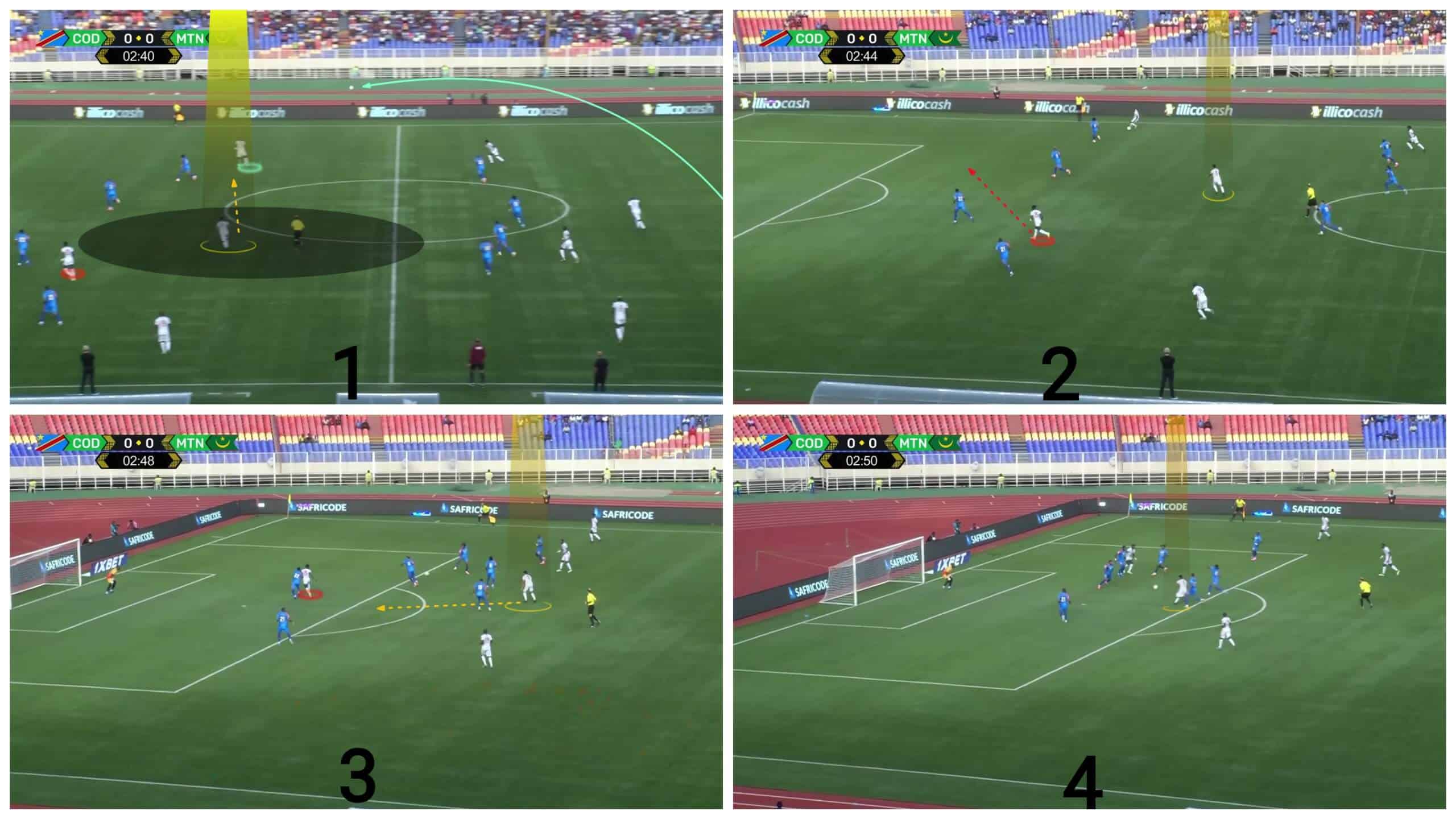
The second thing that highlights him is his good movements and timing, regardless of the finishing itself.
In the first photo, you can observe that he exhibited all the attributes of the proper movement for the striker, as he did not hasten to move while staying concentrated at the beginning behind the defender in his blind side, so he had two options to move in both directions, ahead of him or behind him, and then ended the movement in the goalmouth. At the same time, the defender lost communication with him, as illustrated below, but the header was not optimal.
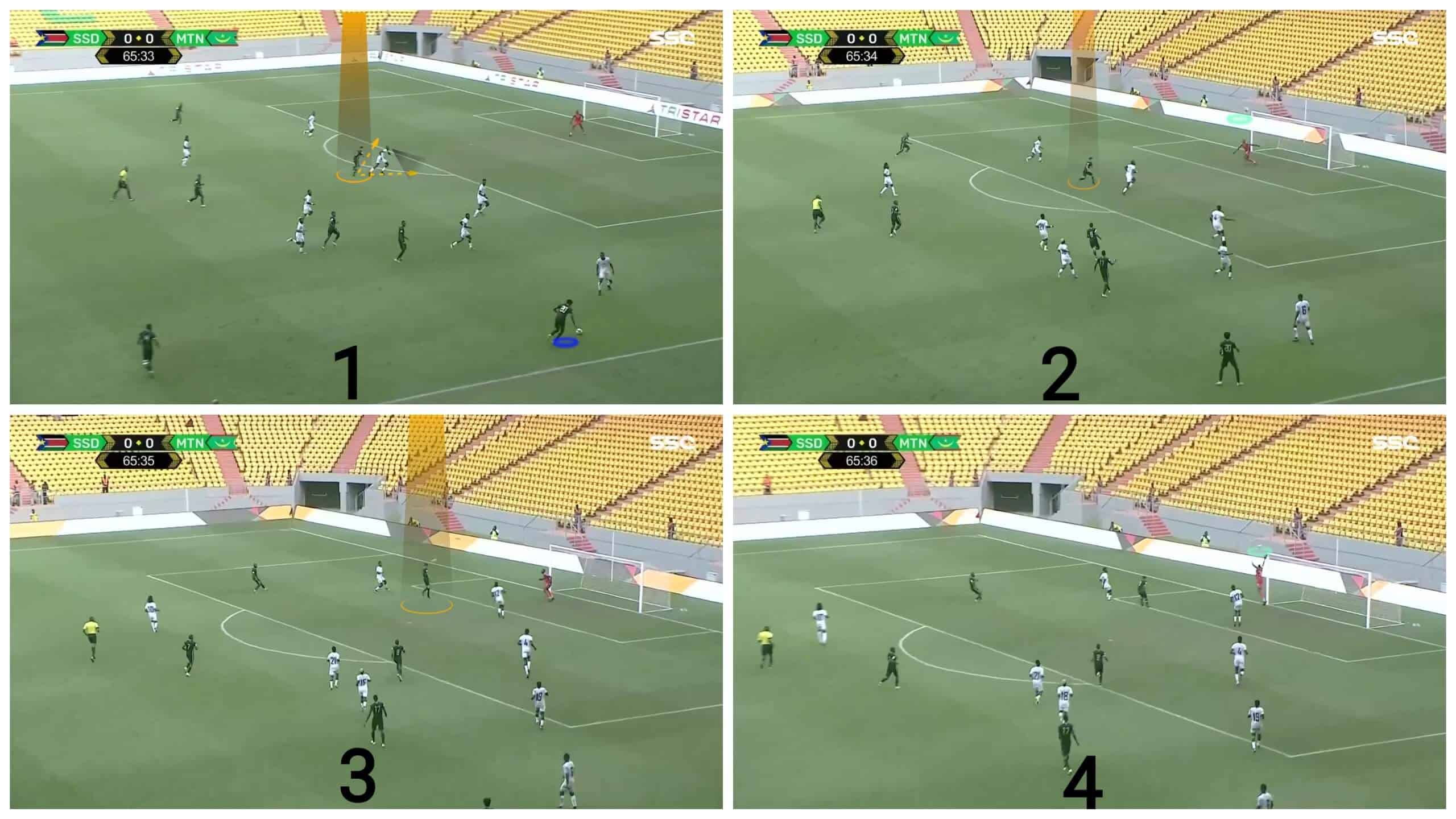
Conclusion
In this analysis, we have discussed the prospects of the Mauritanian national team advancing to the knockout stage for the first time in its history in the Africa Cup of Nations after making its debut in the 2019 edition and qualifying for three consecutive tournaments, which is an encouraging sign.
In this scout report, we investigated the characteristics of the Mauritanian national team in the attacking and defending phases. We found that despite their challenging group, they have the potential to pull off an upset by qualifying or at least performing better than the previous occasions and troubling the big teams. We also discussed their strengths and weaknesses. We have also highlighted a young player who could excel in this tournament.






Comments